

The Ultimate Dolomites Road Trip Guide

Updated February 2024
This ultimate Dolomites road trip guide should show you why visiting South Tyrol was our favorite trip to date. I’ve bookmarked images from the Dolomites for years now and I have to say, the photos do not do it justice. It’s hard to describe how otherworldly this outdoor haven is in person.
After deciding on a 9-day road trip through the Dolomites, we gathered as much information as possible before visiting. This is the first place where we found it quite challenging to get good advice on the overall details of the trip, so I wanted to share all the knowledge we gathered and learned firsthand. This may be my most lengthy blog post to date and it covers almost every aspect of traveling to the Dolomites.
Road tripping in the Dolomites is certainly the best way to see the area as it is the most accessible by car. Having a car affords you the opportunity to explore limitlessly, so I highly recommend it.
Short on Time? Here Are My Top Picks for the Best Hotels in the Dolomites:
- Adler Lodge Hotel (Alpe di Siusi)
- Mandarin Oriental Cristallo (Cortina d’ Ampezzo, opens Summer 2025)
If you’re keen on capturing the breathtaking landscapes of the Dolomites, don’t miss our detailed photography guide to the Dolomites . Additionally, for those looking to explore the hidden gems of this region, our list of 10 places not to miss in the Dolomites and our guide on the best places to hike in the Dolomites are must-reads.
Without further ado, here’s everything you need to know about road tripping through the Dolomites!
What to Know Before Visting the Dolomites
Here are a few good things to note:
- It’s an incredibly seasonal destination. Most towns shut down entirely from October-December and March-April, as do the gondolas (open for ski season). We were on the tail end of the season (second week of October), so we found most places to be empty which was to our benefit for hiking but challenging for restaurants and accommodations.
- A few of the smaller roads will close down for winter seasons, so best not to visit in the midst of winter if you don’t have to.
- Based on research, I think mid-to-late September would be nice, or early summer before the crowds.
- You could spend anywhere from 1-2 weeks here, pending on what you want to do and see.
- Italian and German are the two languages predominantly spoken.
- It feels more like an alpine region like the alps of Switzerland.
- Always carry Euros.
- GPS or good local cell service is necessary for navigating.
- Pack layers — weather changes fast here. We went on a hike wherein one moment it was sunny, then thundering rain, to fog so thick we couldn’t see, and then clear again.
How to Get to the Dolomites
We opted to fly into Venice, Italy as we wanted to return our car to the same place (best option for pricing). Essentially we did one big loop around the Dolomites. You can fly into major airports like Milan, Verona, or even into Innsbruck, Austria pending on what part of the Dolomites you want to spend time in. Flying into Venice is the shortest amount of time for driving if you’re starting on the Cortina d’Ampezzo side of the Dolomites (Tre Cime di Lavaredo) like we were.
Renting a Car for the Dolomites
We partnered with Hertz Europe for this trip to rent our car for the road trip. Picking up our car in Venice when we landed was really easy as the rental car pick up is right in the terminal. We took the “Super Coverage” for our trip and am really thankful we did after driving for the nine days as it gave us peace of mind. I’d recommend booking your car directly with Hertz Europe to ensure your reservation. One thing to note in Italy, an international driver’s permit is needed — AAA is where you can get one in the US. It is crucial if you get pulled over.
Driving in the Dolomites
We’ve driven before in Italy so we were not foreign to the often fast Italian drivers. Be comfortable with roundabouts, other cars passing you on single-lane roads, and always have a look at the signs. There are some tolls on the routes, which you can pay in either cash or card. Most signage is in Italian or German, so be prepared to have to translate some parking signs into English.
One Note: Gas stations often will not take American credit cards. We had to use cash a few times, so be sure to always carry Euros.
Where to Stay in the Dolomites
When it comes to the Dolomites, there are a ton of options for where to stay — it completely depends on what you want to see and do. We did not want to change hotels frequently so we split our time into two sides with 3 nights in Cortina d’Ampezzo and 4 nights in Ortisei (and one final night in Verona). We were really happy with how we allocated our time and the only change would be to add a night in Alpe di Siusi so we could access the road for sunset/sunrise photography.
From Cortina d’Ampezzo and Ortisei, most sights/hikes were only 45 minutes away, so these two towns were the perfect base to return to each night.
Here’s a map to better see the distance between the two areas:
Where to Stay in Cortina d’ Ampezzo
We stayed in a very budget hotel on the Pocol side of the valley and would not recommend being that far over or this hotel. I’d recommend staying in actual Cortina d’ Ampezzo town or on the Cianderies side as that is the road that leads up to most of everything you’ll see.
There are incredible Airbnbs and the hotel that caught my eye was the soon-to-open, Mandarin Oriental Cristallo, which is set to open in Summer 2025.
Other Areas to Consider Staying in Nearby
- A night in the Lago di Braies area.
Where to Stay in Ortisei
We booked an Airbnb for our four nights just on the side of the mountain and were really happy with having a kitchen and a big space to come back to. There are quite a few options on Airbnb, but they must be reserved in advance. For a night in Alpe di Siusi, the Adler Lodge Hotel is a dream and in Ortisei town, I’d recommend the other Adler Spa Resort .
- Val Gardena area
- Castelrotto
- A night in St. Maddalena
Where We Went in the Dolomites
I’m going to split this into two sections, where we went from Cortina d’Ampezzo and where we went from Ortisei. In each point of interest, I’ll also mention where we dined and any other notes of interest.
From Cortina d’Ampezzo
The town of cortina d’ampezzo.
The ski village of Cortina d’Ampezzo is a great base as there is a ton of restaurants and it’s quite charming. One exceptional experience we had was our two lunches at SanBrite . It was a dining experience similar to what you would see on Chef’s Table and their passion for bringing local ingredients to the plate is beautiful. I’d recommend eating here at least once and also at their second restaurant called Agriturismo El Brite de Larieto . For casual food, we dined at La Tavernetta in town twice as we loved the pizza!
Tre Cime di Lavaredo
This is really what we came for. We went into the park two times during our stay. It’s one road in and out (a fee of 17€ to enter) and takes you to the top where the Rifugio Auronzo is (we ate a few meals here between hikes). We did two main hikes in Tre Cime di Lavaredo. The best part is that with little effort, you can get to incredible views here.
- Cadini Group Peaks Hike ( pictured here ) : I had seen the photos of this shot on Instagram and was amazed by how high the peaks are, so we set out to find it. The first time we were unsuccessful as the fog covered the peaks so we walked the wrong direction. The peaks are just in front of where you park. Don’t follow signs for the rifugios, just go right out and follow the one-way trail there. If you can’t find it, just show the photo to someone there and they’ll point you in the direction. It takes about 40 minutes to hike there and sunrise is beautiful here.
- The Three Peaks Hike: This is the main hike that everyone does and it’s in the direction of Rifugio Lavaredo. The first part is really flat (you’ll see everyone going there, all the tour bus groups) and you can stop at the church or keep ascending for incredible views. You could circle around Tre Cime and make your way all the way around. There are two other rifugios along the loop that you can visit for a rest or snack. We stopped at the viewpoint and made our way back as we had done the other half the day before.
Lago di Braies
It’s a beautiful place to catch the sunrise and I highly recommend coming here for a few hours. It can get crowded so be sure to arrive early and pay to park in the lot near the lake. You can rent boats from June until late September from 10 AM until 5 PM for 15.00€ for 30 minutes and 25.00€ for 1 hour.
Nearby, we stumbled by Latteria Tre Cime on the main road to Cortina d’Ampezzo where we stopped in for lunch and a drink. It’s a local creamery and they have cheese plates and a ton of local products — it was the perfect pitstop.
Lago di Sorapis
This was our most challenging and rewarding hike. We showed up incredibly unprepared and with not the right amount of time, resulting in an hour-long hike back in the dark forest (not recommended). So first off, allow yourself the proper amount of time — from the parking location at Son Zuogo , it is a good 4 hours round trip with no stops. The trail can be challenging to follow, so be sure to follow the markers. There are always a ton of hikers, so ask if you need help. The ascent goes along a very steep path on the side of the cliff with no railing, though there are cables to hang onto. It’s an effort, but this lake is one of the most beautiful places I’ve seen.
From Ortisei
Gardena pass.
On the way to Ortisei, we stopped off here to snap a photo of one of the windiest roads in the Dolomites. It’s so beautiful and loved the views from here.
Ortisei Town
This is where we were based so we popped into town for a few meals and for grocery shopping. We ate at Cascade Pizzeria twice when we were in town. There’s not a ton going on during the off season, but I’d imagine it gets quite busy during peak months.
Val di Funes
We spent a full afternoon exploring Val di Funes by car and it was one of our favorite areas, especially for photography. It’s incredibly picturesque, and we stopped at iconic St Johann in Ranui Church. Afterward, we caught the sunset over the valley and Santa Maddalena from the famous lookout here . We capped off the night with a yummy dinner at Waldschenke in the valley where we had some local dishes.
Our favorite place we saw in the entire Dolomite region was Seceda. We spent the entire day on the mountain soaking in the views and hiking around. To get to the top, you take the gondola from Ortisei town (it’s 30€ per person roundtrip and runs from 8:3-5:30 from June 2 -October 14, dates may change). We had lunch at Baita Troier on the mountain, hiked to Malga Pieralongia Alm hut to see the free-roaming donkeys, and then returned back to the gondola.
Alpe di Siusi
If there is one place not to miss, it’s Alpe di Siusi. It’s the largest alpine meadow in Europe and breathtaking. It can be confusing on how to visit as the roads are closed for the public unless staying at a hotel or arriving before 9 am or after 5 pm to the parking lots in Compatsch . Read my in-depth guide to visiting Alpe Di Siusi for all of the exact details on how to visit this area and the other components of parking or taking the gondola up. The easiest access is the gondola ride from Ortisei.
We spent most of the day hiking around the valley and out to Malga Sanon for an incredible breakfast with the best views. Afterwards, we hiked back to the parking lot and soaked in the scenes along the way. On our way back to Ortisei, we stopped and had lunch at a beautiful farm/hotel called Lafogl .
Another great viewpoint in the area is the drive through the Sella Pass. There are hikes here, though we just stopped to soak in the views of the Sassolungo Peaks.
Lago di Carezza
We had one more free afternoon, so we took the scenic route to see the incredible colors of Lago di Carezza. Along the way, we dined at Ristorante Hennenstall for a filling lunch in a beautiful space. Afterwards, we went to the lake and walked around to enjoy the views. It’s important to note that you can’t actually walk down to the water’s edge as you may see a ton of IG posts from there — there’s a fence which some have jumped over.
Save This Post for Later on Pinterest
Ps — are you booking a trip soon use my booking checklist.
These are the sites I use most to book my own trips. Using the links below is a great way to support Bon Traveler’s travel journalism at no extra cost to you . If you need help organizing your itinerary, get my free travel itinerary template here .
1. Book Your Flights
Use Skyscanner to find the best flights. It searches 100s of airlines and websites across the globe to ensure you’re not missing out on any route options or deals.
2. Book Your Accommodations
Use Booking.com for hotels and guest houses. They have the biggest inventory and consistently offer the best rates.
3. Book Your Tours & Experiences
Use Viator or Get Your Guide to find the best tours and experiences. They are my favorite tour search engines. I always check both as their inventory varies depending on the destination.
4. Book Your Car
Use Discover Cars or Rentalcars.com to find the best car rental deals. I recommend comparing rental agency reviews on Google to ensure you are booking with the best company in that destination, as the reviews are often more accurate than the car rental search engines.
5. Don’t Forget Airport Lounge Access
Get a Priority Pass membership to gain access to 1,400+ VIP lounges and airport experiences worldwide. The Priority Pass app is the first thing I check when I have a layover. I’ve been a member for over a decade, and having a comfortable place to relax before and between flights makes air travel so much more enjoyable.
6. Don’t Forget Travel Insurance
I never leave the country without travel insurance. It provides comprehensive protection in case anything goes wrong (ie. illness, injury, theft, and cancelations, etc.). I use it frequently for my travels to stay protected.
My favorite companies that offer the best coverage and rates are:
- World Nomads (best for all-around)
- Safety Wing (best for frequent travelers)
Xx, Jessica
Related Posts
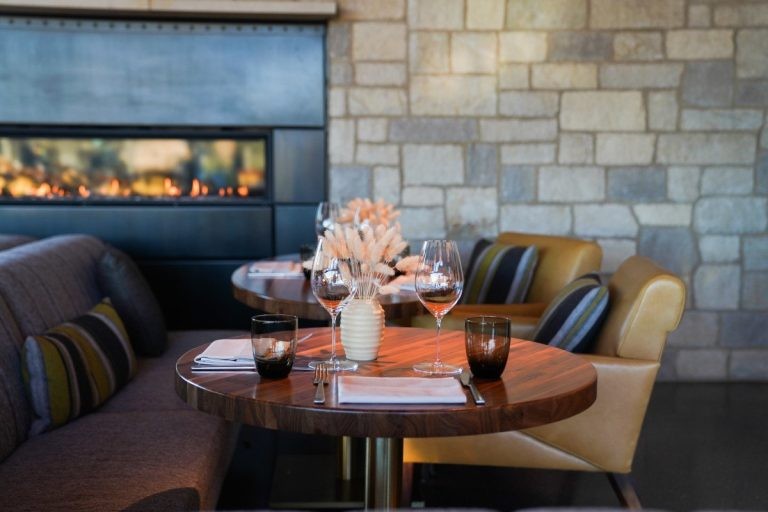
The 20 Best Restaurants in Napa Valley (2024)
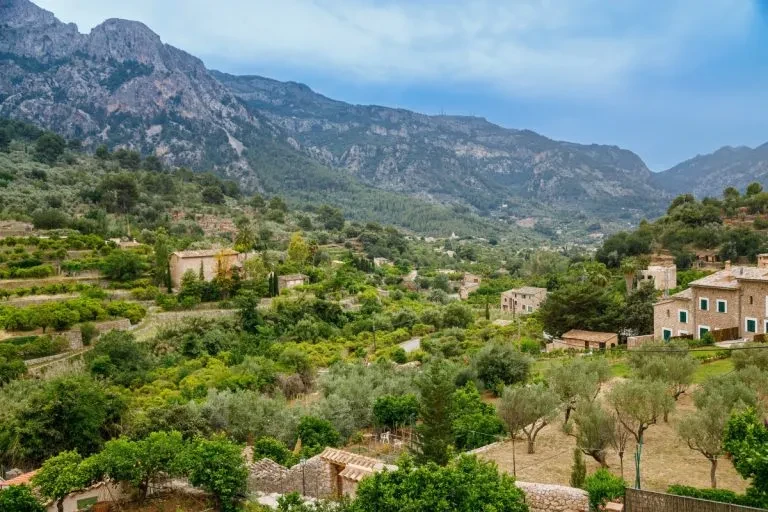
The Ultimate Travel Guide to Fornalutx, Mallorca
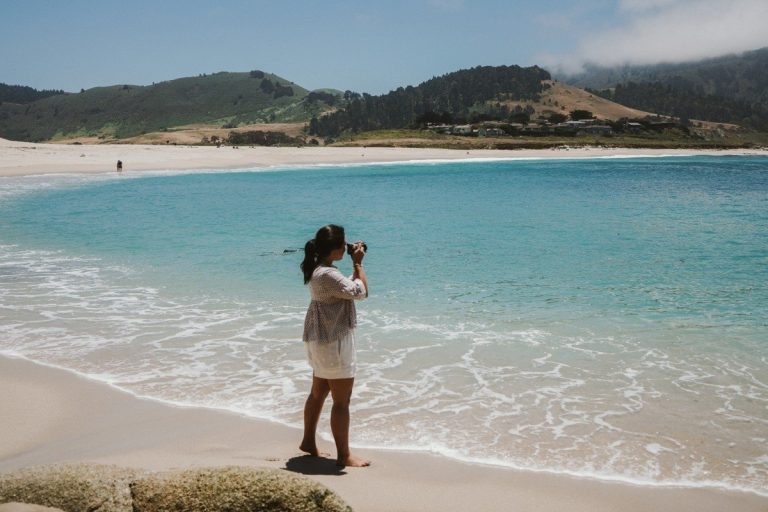
The Ultimate Weekend Guide to Carmel-by-the-Sea, California
21 comments.
I have been searching for dolomites tips and this is the best blog I’ve found yet! I am planning a trip through Italy for my honeymoon and am so excited to explore the dolomites. Thank you for sharing this!! – Amanda
Ah thank you! That makes me so happy to hear!!
I only have 3 days to go to the Dolomites and we like to walk but we are not really the hiker type of people, where do you recommend we go or stay for those 3 days?
I would recommend the area of Alpe de Suisi or Lago di Braies.
Hi Jessica, I wish I had found your blog a little bit earlier to plan my accomodations. But anyway we are going to explore Dolomites in a Campervan for 10 days next week and I’m having a hard time to find informations about caravan parks or where we can park to sleep. Would you know anything about that? Thank you so much for your precious informations in this amazing blog!
Hello! Unfortunately, I don’t know anything about the caravan parks so I can’t help much on that one.
Were these day hikes or did you camp? love your detailed blog post of the dolomites! pictures look gorgeous!
these were all day hikes!
What a great post! I am in the early planning stages of a trip here (hopefully for next summer as I love lake swimming) and this is so far the best resource I have found
Your pictures are mind blowing. Loved it. We are planning for short Dolomites trip this october end for 4 days. (I know not a good time) Though we are no where close to Hiking. 🙂 So for us main thing is Scenic views and strolling around.
Can you please help us ?
Current Itinerary –
Day 1 – Land in Verona Early morning Rent the Car Drive to Riva del Garda (2 hrs) From there move along towards Bolzano to catch Great Dolomites Road(Check Lake carrazza, sella pass, …) to reach Cortina dʼAmpezzo
Day 2- Check Cortina dʼAmpezzo and Tre Cime di Lavaredo
Day 3- Early Morning – Lake Braies and then head to Ortesie
Day 4 – Val Garden , and Alpe de siuise and head back to Verona
Does this sound good?
Hey Kunal, this sounds great and should hit the major spots!
High Jessica.Thank you for your wonderful blog and pics .We are flying from New York to Milano on September 23 and will be in the area for 5-6 days.Will follow all your recommendations .We are arriving very early on the 24th and will pick a car at the airport and we’re thinking of driving to Bolzano(2 1/2 hours drive) to rest from the long flight and then drive to Ortisei the following morning to start your route (In the opposite direction) We are thinking of staying two nights in Ortisei and three in Cortina de Ampezzo.Do you think that we should drive directly to Ortisei from Milano?(It is a 37 minutes drive from Bolzano) and rest there instead? That will give us and extra day in the region. I am 72 years old and my friend 56.We love to walk and can do 3-4 miles a day in the city without problems.Do you think we would we able to endure the walk on the trails that you describe? And If we have to omit one or two of the sites because of the shorter stay,which ones would you recommend? We like photography,and prefer to take landscapes of meadows,lakes ,mountains and small villages. Would appreciate very much your opinion.Thank you and have a good day.
Hi Jessica,
Thanks for your thorough blog. I’m exciting for my upcoming trip. I had one quick question: did you have any trouble driving through the routes with your car? Did you need to have 4W drive in any instances? I have rented a car but it’s a Ford Focus so I want to avoid any dangerous areas if I can’t make it through with it.
You shouldn’t need 4WD as long as there is no snow!
Awesome, thank you!!
Hello Jessica, This is a super guide – thank you so much for sharing! I am planning a trip next year to the Dolomites and we are bringing our car from Ireland and will travel through France/Switzerland first. We are not ‘hikers’ though do enjoy easy walking in the countryside. Your photograpjy is stunning, and we are really going to experience something like that. My question is this: Do you think it is worth doing the ‘loop’ as you have mentioned? We will probably travel to Ortisei from Innsbruck, and I am thinking that to base ourselves in Ortisie and Cortina each for a few nights will give us access to the most beautiful scenery?…or would you recommend we complete the loop? Are there any of your locations that you would advise ‘non-hikers’ to undertake?!! Any advice greatly appreciated! Teresa.
Hey Teresa, most of these places are reachable by car or by a light walk so I think it is easy to do without a huge hike. I’d recommend basing out of Cortina and Ortisei to see all of this.
The loop at mentioned for Tre Cime may be a bit more challenging as there is an upgrade in the hike. Hope this helps!
Thanks for this blog post, it’s very informative!
We are planning a trip for next September and would like to know if you found driving through the Dolomites dangerous due to the high peaks? We can see that renting a car is the best option but wanted to check as it would be the first time driving abroad.
Hey Kim. The roads are very well marked and though some are in the mountains, there are hardly any dirt roads you will go on. The majority of all drives are tourist routes which mean they’re easy to use. Of course, driving abroad means a lot of signage in other languages but its quite easy to figure out after a day. I’d recommend having cell service or google maps on at least one phone.
I created a folder on the Dolomites years ago and have been on Pinterest and came across your article. This is really helpful information. My husband and I will be flying into Milan in mid-September for 1 night, then 2 nights at Lake Como. From there – we had hoped to rent a car in Como then spend 4 days driving around Dolomites – then drop the car back at Como the fly out of Milan. If you could only spend 3 to 4 days driving through the Dolomites – what would you suggest. We will hike a little – but really do not have the time on this trip.
I think being near alpe di suisi would provide many options to explore the Dolomites.
Write A Comment Cancel Reply
Save my name, email, and website in this browser for the next time I comment.
- Cayman Islands
- Dominican Republic
- Puerto Rico
- South Dakota
- Washington DC
- Czech Republic
- Netherlands
- Switzerland
- French Polynesia
- Travel Tips
- Family Travel
- Accommodations
- Packing Lists
- Photography Tips
- Northern California Guide
- San Francisco
- Lightroom Presets
- Fine Art Prints
- Rent Our Home For Photoshoots
- California Map
Type above and press Enter to search. Press Esc to cancel.
Where to Go Hiking
Where to Go Skiing
Best Time to Visit
Weather & Climate
Best Destinations
Top Cities to Visit
Must-Try Foods
Two-Week Itinerary
Things to Do
Best Beaches
Best Museums
Dolomites Guide
Italy's Dolomites Region: The Complete Guide
:max_bytes(150000):strip_icc():format(webp)/ElizabethHeath-Headshot-horiz-e7525e97616245958bf3d94e8db7f119.png)
How to Get There
Weather in the dolomites, things to do in the dolomites.
- Dolomites Towns & Cities to Visit
Where to Ski
- Where to Hike, Bike & Climb
Where to Stay
- Frequently Asked Questions
A favorite destination of nature lovers, the Dolomites, or Dolomiti in Italian, is a mountainous region that is part of the Northern Italian Alps. Dominated by 18 majestic peaks, its diverse landscape consists of more than 350,000 acres of jagged pinnacles, sheer rock faces, icy glaciers, deep gorges, lush forests, and verdant valleys. There are 2,131 named mountains in the Dolomites region; Marmolada, which boasts Punta Penía, the highest peak of the mountain range, is nicknamed the "Queen of the Dolomites." Because of its stunning beauty and well-preserved Mesozoic carbonate platform system that was formed 250 million years ago, the Dolomites were named a UNESCO World Heritage Site in 2009.
Throughout the Dolomites, towns and villages dot the countryside, each part of a fascinating smorgasbord of unique customs and languages. In fact, prior to the end of World War I, South Tyrol and Trentino were part of Austria, which explains why 75 percent of the region's population speaks German as their first language.
The Dolomites straddle the northeastern border between Italy and Austria, running through the Italian provinces of Belluno, Alto Adige (also called South Tyrol), and Trentino. The highest point of the mountain rises nearly 11,000 feet above sea level.
The journey from Milan to Bolzano takes a little over 3 hours by car or train. While it's possible to see a lot of the Dolomites by train or regional bus, many travelers prefer to rent a car for exploring small towns and natural areas not on public transportation routes.
Weather can change abruptly in the Dolomites, so be prepared for anything. Autumn generally comes early with frost present as early as late August. People flock to the region to see the explosion of color that the fall foliage, before winter blankets the landscape with snow that may not melt until late spring. Summers are short but beautifully lush and green.
Replete with dramatic crests and unspoiled lakes, rivers, woodlands, and meadows, the region draws visitors year-round, with most coming for summer or winter sports.
Here's a list of some things of the great things to do in the Dolomites.
- Ski and Snowboard Spectacular Slopes: Its clean air, pristine surroundings, and lofty summits make the Dolomites an ideal place for all manner of outdoor winter sports. Depending on annual snowfall, slopes at the highest elevations may open by early fall and remain open until late spring.
- Tackle a Via Ferrata Climbing Route: A via ferrata (sometimes referred to in the plural as vie ferrate ) is a protected climbing route outfitted with steel cables affixed to the rock face, that climbers can use to secure themselves. Each via ferrata is ranked by difficulty — determined by the steepness and the length between the holds. The most sought-after vie ferrate are found near Cortina, Alta Badia, and Val di Fassa.
- Take a Breathtaking Drive on the Great Dolomites Road: One way to see the Dolomites up close is to plan a car trip along the breathtaking Great Dolomites Road ( Grande Strada delle Dolomiti ). An engineering feat, the highway cuts through the mountains beginning outside Bolzano and ending in Cortina d'Ampezzo.
- Barrel Downhill on a Mountain Bike: Mountain biking is a popular pastime in the mild climate during the summer months. Whether you join a private biking tour or strike out on your own, you'll enjoy stunning views along winding trails and bumpy cycling paths.
- Soar Over Snow Capped Peaks in a Hot Air Balloon: In early-to-mid January, the skies over Dobbiaco are filled with hundreds of hot air balloons participating in the annual Balloon Week festival. Book a private balloon tour that takes you up, up and away for a bird's eye view of the Dolomites' Alta Pusteria valley.
Dolomites Towns & Cities to Visit
- Belluno: The alpine town of Belluno is considered the gateway to the Dolomites. Nestled between the Piave and Ardo rivers, this charming city is surrounded by meadows and rolling hills, making it the perfect home base for mountain biking, and trekking.
- Bolzano-Bozen: The capital of South Tyrol, Bolzano, has lovely parks, flower-lined promenades, and a cog railway and cable-car that ferry passengers up to ski areas and plateaus with stunning views of the surrounding peaks. Must-sees include the Duomo di Bolzano and the Archaeological Museum where you can meet Ötzi the Iceman, an incredibly well-preserved glacial mummy dating back to the Copper Age.
- Brunico-Bruneck: Brunico was founded in the 13th-century and is the largest town in the South Tyrol holiday area of Kronplatz. Adjacent to the ritzy Plan de Corones ski resort, other popular attractions in town includes Brunico Castle and the Messner Mountain Museum.
- Cortina d'Ampezzo: Cortina d'Ampezzo is a fashionable village in the province of Belluno. Not only does Cortina have an abundance of scenery, but it also boasts museums, art galleries, fine-dining restaurants, luxury hotels, plus one of the most famous ski resorts in the world. In the summertime, mountain climbers flock to the area to try their hand at the challenging via ferrata hiking trails nearby.
- Merano: Merano is a pretty spa town best known for attracting literary figures as Franz Kafka and Ezra Pound. Its main thoroughfare of smart shops and fancy hotels ranks second only to its beautiful gardens that line the River Passirio.
- Val Gardena Ski Resort: High in the Dolomites, Val Gardena in South Tyrol is an international holiday spot frequented by winter sports enthusiasts. Part of the Sella Ronda circuit, Val Gardena sports 80 lifts and more than 300 miles of connected slopes. The village of Selva Gardena offers visitors plenty of opportunities for cultural events and leisure activities.
- Cortina d'Ampezzo Ski Resort: One of the world's most lavish ski resorts, the slopes at Cortina d'Ampezzo are ideal for beginning-to-intermediate skiers. It has 47 lifts and offers an array of fun activities for families such as tobogganing, bobsledding, ice skating, and even hockey.
- Ortisei Ski Resort: Best known for its outstanding cross-country skiing, Ortisei Ski Resort is located in the Val Gardena valley. After exploring the quaint little town, you can take the narrow-gauge railway up to the 8,000-foot summit to see one of the most beautiful alpine pastures in all of Italy.
Where to Hike, Bike & Climb
- Hiking: A must for enthusiastic hikers and climbers, the Belluno Dolomites National Park is a nature reserve with glaciers, waterfalls, forests, and archaeology museums. Renon-Ritten is another hiker's paradise, perched on a plateau that overlooks the city of Bolzano.
- Mountain Biking: For the more daring cyclist, the Herrensteigh in the Kronplatz area offers a variety of challenging downhill and freeride trails.
- Mountaineering: Monte Cristallo is located in the center of the Dolomites and has four peaks, making up the Cristallo group. The highest reaches an elevation of over 10,000 feet and can be explored by cable car or by scaling one of its three via ferrata routes. The 1993 movie "Cliffhanger," with Sylvester Stallone was filmed there.
- Luxury Hotels: The Hotel Miramonti is a popular luxury choice, especially for couples. It features jaw-dropping views of the Dolomites from a 4,000 foot high vista point. Other great luxury options include 1477 Reichhalter , Villa Arnica , Rosa Alpina , and Hotel La Perla .
- Wellness Hotels: Why not spend your time in the Dolomites indulging in pampering treatments and unwinding in thermal spas? Adler Spa Dolomiti boasts a ski lodge vibe with excellent spa services. The stunning boutique wellness sanctuary Forestis was once a retreat for Popes. And the LeFay Resort & Spa Dolomiti offers four floors of spa services, one of the largest spas in the Alps.
- Mountain & Alpine Huts: Also referred to as refuges, mountain or alpine huts are sprinkled all over the Dolomites. They serve as a rest stop where hikers and mountain climbers can grab a hearty meal before heading back out on the trail again. Rifugio Locatelli is one of the most popular options; booking ahead is highly recommended.
The official website of the South Tyrol has loads of information on things to do and places to stay in the Dolomites.
The Dolomites straddle the northeastern border between Italy and Austria.
The Dolomites are a mountainous region that is part of the Northern Italian Alps.
The journey from Milan to Bolzano, the "Gateway to the Dolomites," takes a little over 3 hours by car or train.
The 15 Best Destinations in Italy
Best Places to Go in Northern Italy's Veneto Region
The Top Spots for Skiing and Winter Sports in Italy
Your Trip to Switzerland: The Complete Guide
The Top Cities to Visit in Trentino Alto Adige, Italy
The Top 23 Things to Do in Italy
The 9 Best Ski Resorts in Italy
A Guide to Italy's Wine Regions
The Lakes of Northern Italy
Yosemite National Park: The Complete Guide
Veneto Region of Northern Italy: Tourist Map With Cities
Hiking in Switzerland
10 Best Honeymoon Destinations in the Mountains
12 Best Small Towns in Colorado
13 Top Things to Do at Lake Tahoe
The Top 10 Things to Do in Bolzano, Italy
Quiz: Which San Diego Adventure is Right for You?

THE ULTIMATE 5 DAY DOLOMITES ROAD TRIP ITINERARY
Summary: A breakdown of my day by day Dolomites road trip itinerary plus my suggested packing list.
The Dolomites in Italy had always been on my bucket list after seeing pictures of the mountains all over Instagram. I wasn’t quite sure what to expect, but after visiting, the Dolomites quickly became one of my favorite places in the world.
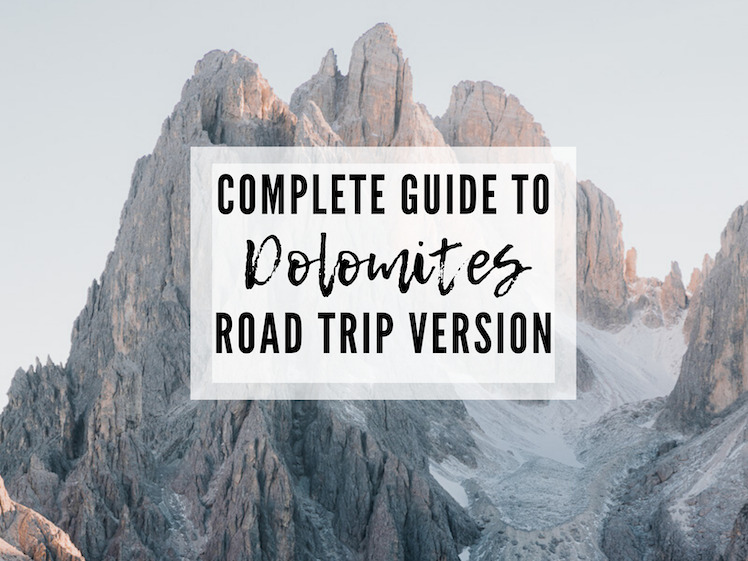
Because I love this place so much, I wanted to share my ultimate 5 day Dolomites road trip itinerary with you. In this guide, you will find all the information on where to stay, what to see, and even my suggested Dolomites packing list.
This itinerary is also perfectly suited for the outdoor adventurer and photographer!
I have been to quite a few mountainous areas like Colorado, New Zealand, Montana, and much more!
PLANNING THE ULTIMATE DOLOMITES ROAD TRIP: ESSENTIAL THINGS TO KNOW
The Dolomites are a dramatic mountain range located in Northern Italy close to Austria and Switzerland. In the quaint towns within the region, you will be surprised to find Austrian-inspired architecture as the Dolomites were actually part of Austria at one point before they became a part of Italy.
There are some essential things you should know prior to planning your Dolomites vacation.
HOW TO GET TO THE DOLOMITES
Getting to the Dolomites can be a little difficult as it is quite remote, but don’t let that deter you from visiting. I am here to help you plan this trip and to make it as smooth as possible for you!
As you will find below, the Dolomites is best explored by car as many of the locations are spread out and public transportation is not easily accessible here. First, let’s talk about what airport you need to fly into.
So, how did we personally get to the Dolomites? We had been exploring Italy for two weeks prior to visiting the Dolomites, so for us, we needed to figure out the best spot to go from.
And that was Venice. Here is exactly what we did.
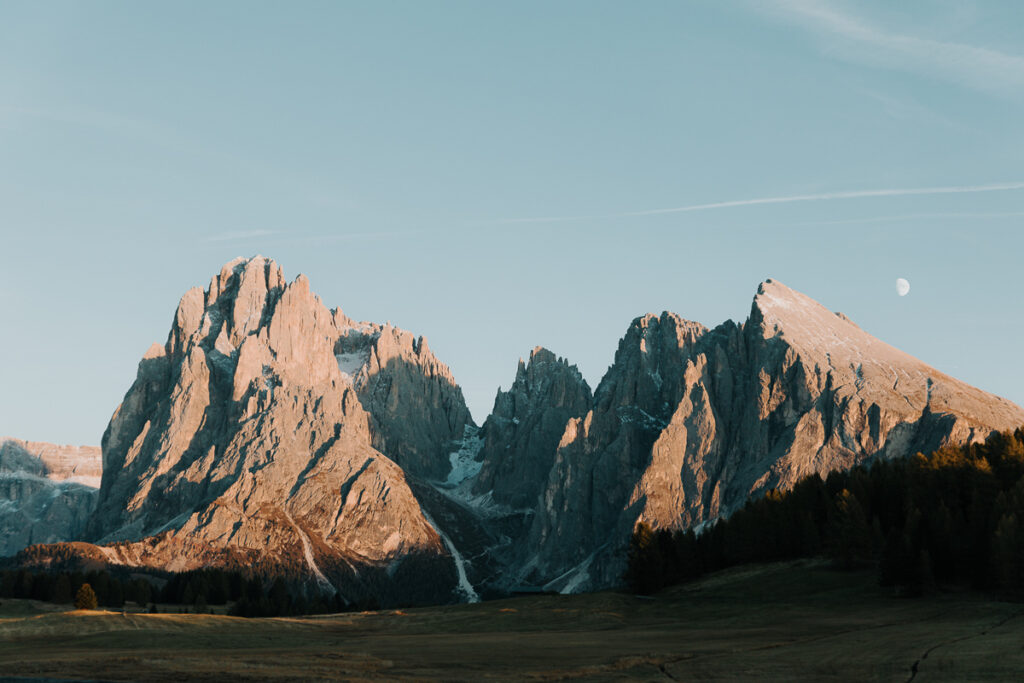
First off, did you know Venice does not have any cars? Everything is done via a water taxi. So, we left our Airbnb in the morning and took a water taxi from our Airbnb to the Marco Polo Venice airport. Once we arrived at the airport, we rented a car and drove for 3.5 hours to the Dolomites region.
After much research, we went with Budget car rentals and chose a small SUV for our Dolomites road trip. The final cost came out to around $500 for 5 days of a car rental.
Tip: European cars tend to have smaller trunks than American cars. If you are anything like us you packed a lot for this trip but don’t want to take it all with you to the Dolomites. There are storage lockers in Venice that cost around $65 for the 5 days.
Another great option would be to fly into Milan, rent a car, and drive four hours to reach your destination. Northern Italy can be reached by multiple airports, but regardless of which airport you choose you will need to rent a car and drive to your end destination in the Dolomites.
Below you can find the driving times from the surrounding airports:
Budapest, Hungary-9 hours
Milan, Italy-4 hours
Munich, Germany-3-4 hours
Zurich, Switzerland 5-6 hours
Venice, Italy- 3.5 hours
BEST TIME TO VISIT THE DOLOMITES
Honestly, the Dolomites can be visited at any time of year, but personally, I think the best time to visit is in the Fall season. Let’s talk about why below.
In the winter, this area becomes a huge ski region, therefore if you are not into skiing then this might not be the best time for you. Although the snow-capped mountains are probably gorgeous I would say there is not much to do other than ski during the winter.
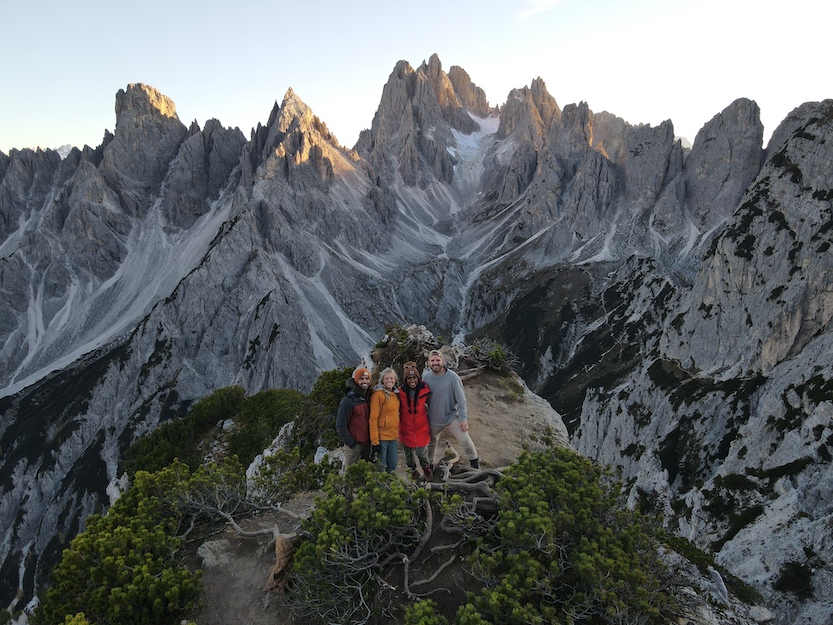
Visiting in the Fall allows you to still be able to hike the mountain ranges as well as experience the glory of all the Fall colors. During this season, you will most likely find fewer crowds, great weather, and “off-season” prices.
For your best chance at seeing Fall colors, I recommend visiting in October. We visited October 15th-19th and the colors were just starting to pop.
Do note, the Dolomites region is essentially a tourist town. If you choose to visit in the off-season you may find a lot of the hotels and restaurants have already closed for the season and don’t re-open until ski season begins.
This doesn’t mean you can’t visit during that time of year, it just means you may have to pack a few extra snacks for your hikes and day trips.

HOW MUCH TIME TO SPEND IN THE DOLOMITES
Man, I could spend forever in the Dolomites haha. This mountain region was so magical to me and there are a never-ending amount of lakes and mountains to explore. BUT, if we must narrow it down, then I recommend spending anywhere between 5-7 days here.
Our trip was basically split up into two main regions: Ortisei and Cortina D’ Ampezzo.
THINGS TO KNOW BEFORE VISITING
-There are a lot of tolls on the major highways, so be prepared to pay for these. Credit card is accepted
-There are a lot of speed cameras. Our rental car actually beeped and warned us when a speed camera was coming up.
-Most people speak English here, so it was fairly easy to get by
-If you are visiting the off-season a lot of the refugios, hotels, and restaurants will be closed for the season.
-Although there are a ton of beautiful hotels with insane views, we opted to stay in Airbnbs as those were definitely the more affordable options
-It can get quite cold being high up in the mountains, so make sure to check out my packing list below.
-The Euro is the currency used in the Dolomites, but we found most places accepts card
SPECIFIC TIPS FOR DRIVING IN THE DOLOMITES (Seiser area)
-It is forbidden to drive in the meadow region of Seiser Alm
-If driving in the Seiser Alm region, you can only drive before 9am and you can’t go any further than the main parking lot in Compatsch.
-You can’t drive up the roads between 9am-5pm; however if you arrived before 9am you can drive down any time you want
DOLOMITES ROAD TRIP ITINERARY DAY BY DAY
Alright, let’s get to it! I hope you use this Dolomites road trip itinerary to help you plan your trip and have the time of your life!
Below I will discuss the highlights that you shouldn’t miss. For your first two nights, you will be staying in the town of Ortisei.
DAY 1 OF YOUR DOLOMITES ROAD TRIP
The first day of your Dolomites road trip itinerary is all about driving to your destination. Most of your morning and early afternoon will consist of picking up your car and driving to your destination.
You will be staying in the town of Ortisei. Your first day is what I like to call the “let’s get settled in” day. So, you will only be making one stop this day.
I recommend stopping for lunch somewhere in town and then grabbing some groceries prior to seeing your first Dolomites attraction.
Stop 1: St. Valentin Church
This church can be easily accessed via a short walk. There are two routes to get to this chapel.
Either begin near the village center of Seis and look for a brick-paved path that winds up the hillside toward the chapel. You will come across another path carved under a row of trees that brings you to the chapel steps.
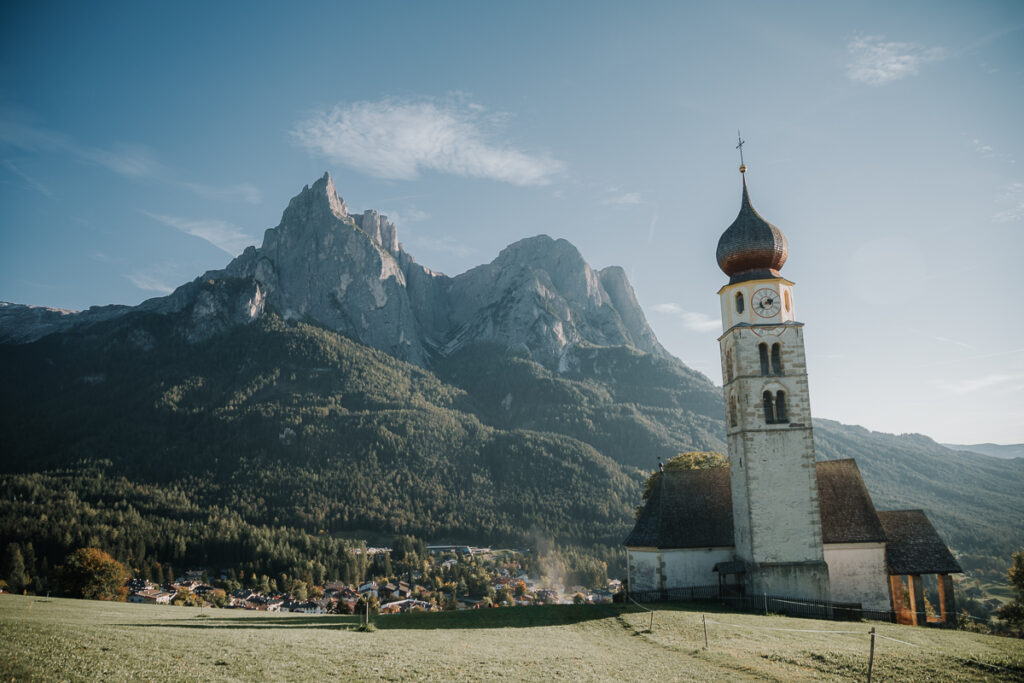
Or if you want an even shorter option drive to the destination, find a place to park along the road, and just walk to the chapel. There are areas that are fenced off, so please remember to follow the LNT principles and avoid those areas.
Stop 2: Malga Sanon
If you are looking for a great sunset location then I recommend your next stop being Malga Sanon. We were able to drive directly to this location. There is a refugio here where you could normally grab something to eat, but it was closed when we visited.
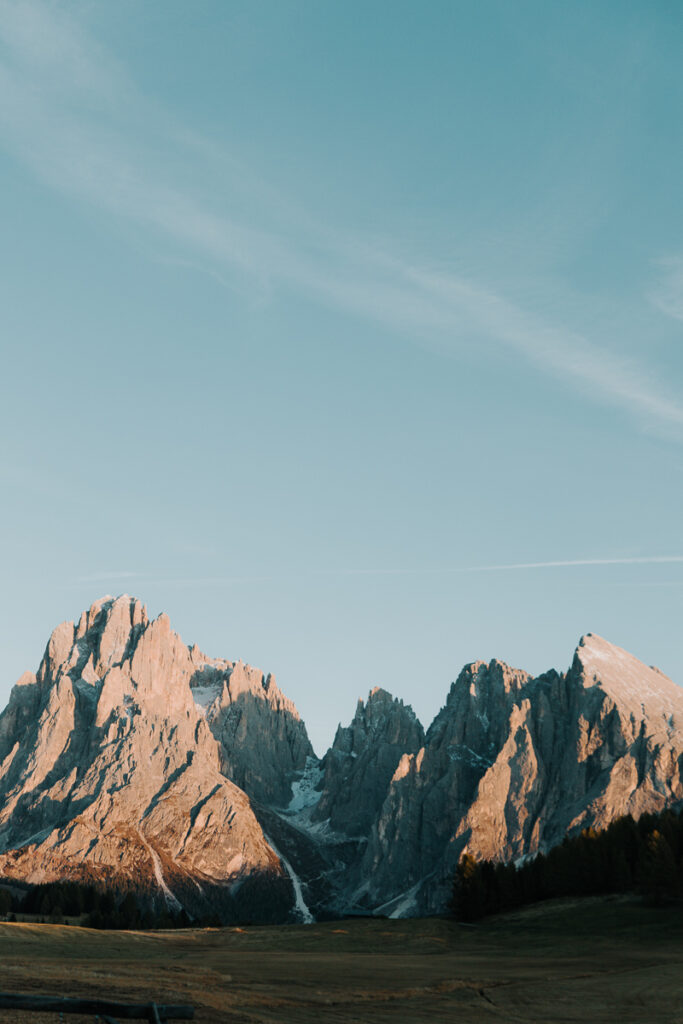
Here you will find a tiny playground with a swing. I have never swung on a swing with a more gorgeous backdrop. See the picture below.
Optional Stop: Lago Di Carezza
If you have additional time, I recommend stopping at Lago di Carezza. We, unfortunately, ran out of time and were not able to make it here, but the pictures look gorgeous. It is about 30 minutes out of the way.
If you are coming from Venice, then I would recommend making this stop first. This lake is often called “Rainbow Lake” due to its extravagant colors. This entire lake is now fenced off, so again please respect the LNT policies and do not hop the fence for a better picture.
Our accommodation for the night was in a cute Airbnb in the town of Ortisei. We split the cost with another couple we were traveling with.
DAY 2 OF YOUR DOLOMITES ROAD TRIP
Our original plan was to hike Seceda, but because we were visiting in the off-season the Gondola to get here was closed-meaning we would have had to hike about 9.5 miles. Although I am up for a good hike, I happened to be 23 weeks pregnant during this trip and that didn’t sound all that fun to me.
I have heard this hike is quite steep and can be cold, so if you choose to do it make sure you pack enough layers and lots of water!
Stop 1: Gondola the hike to Saltria
We chose to take the Mount Seuc Gondola located right in the town of Ortisei to the top and from there we began a different hike.
There were multiple hiking route options once we reached the top: we chose to hike to Saltria. The signposts give you an idea as to how long each hike should take.
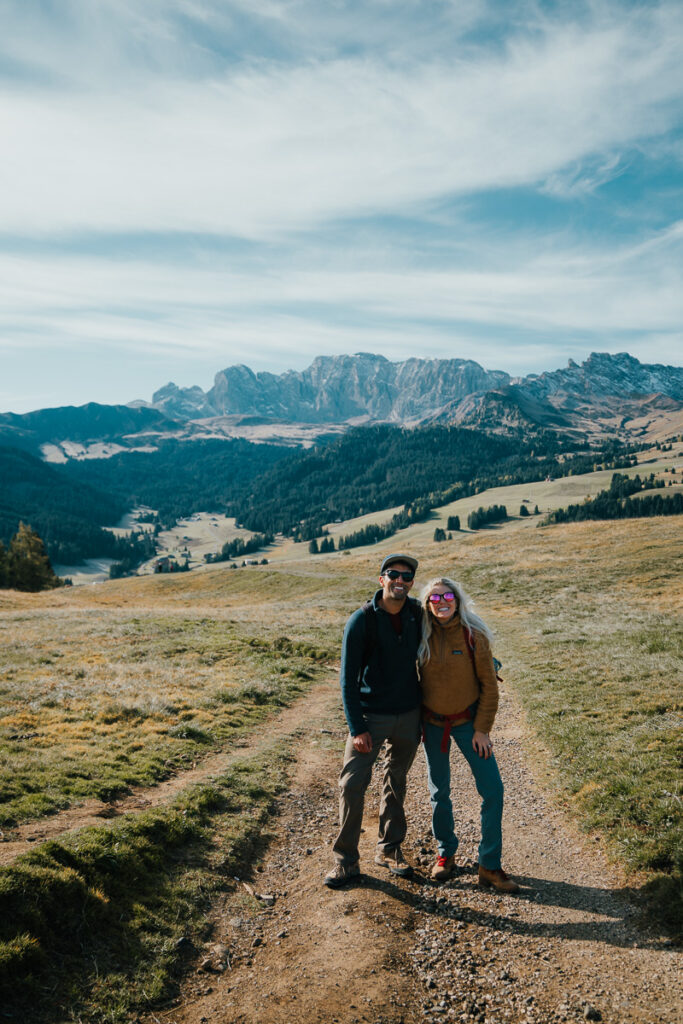
The hike to Saltria was gorgeous and mostly downhill the whole way. Once we reached the town of Saltria we found a refugio that was open for lunch, so we refueled our bodies with some bratwurst before beginning the uphill trek back to the Gondola.
Stop 2: Val Di Funes
It takes about 45 minutes to get to the Val Di Funes area from Ortisei. After a long day of hiking, we chose to watch the sunset in this area. Here you will find some of the most beautiful churches.
Your first stop will be at one of the most photographed places in the Dolomites, the church of Santa Magdalena. Unfortunately, you cannot drive up to the famous viewpoint for this church, but there is a small parking lot close by, and from there you can hike 20 minutes uphill to the viewpoint.
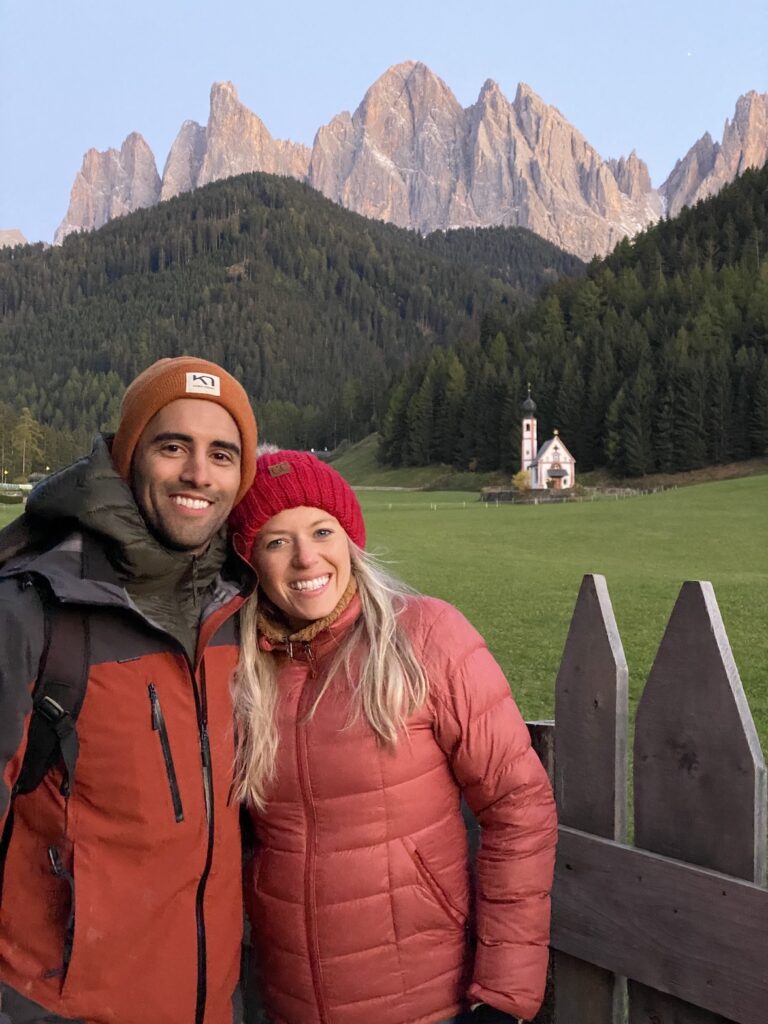
You will need to get back in your car to drive to the next location. (You can walk between the two destinations, but it will take you about 30 minutes.
Your second stop will be the Church of St. Johann (on google maps this is listed as Kirche St. Johann in Ranui). This church has an insanely beautiful background. There is a wooden viewing platform close to the parking lot. You can visit the inside of the church itself, but it does cost money.
Personally, I think the views are best from the wooden viewing platform.
We stayed in the same Airbnb in Ortisei this night: Brand new Airbnb 2BR 2BA – $674 Total for 2 Nights ($337 each)
DAY 3 OF YOUR DOLOMITES ROAD TRIP
Stop 1: gardena pass.
Our morning started off with a sunrise photo session at Gardena Pass as we headed towards the next area of the Dolomites that we would be staying in.
This is a super scenic mountain pass that connects Val Gardena with Val Badia ultimately getting you to your next destination of Cortina d’Ampezzo.
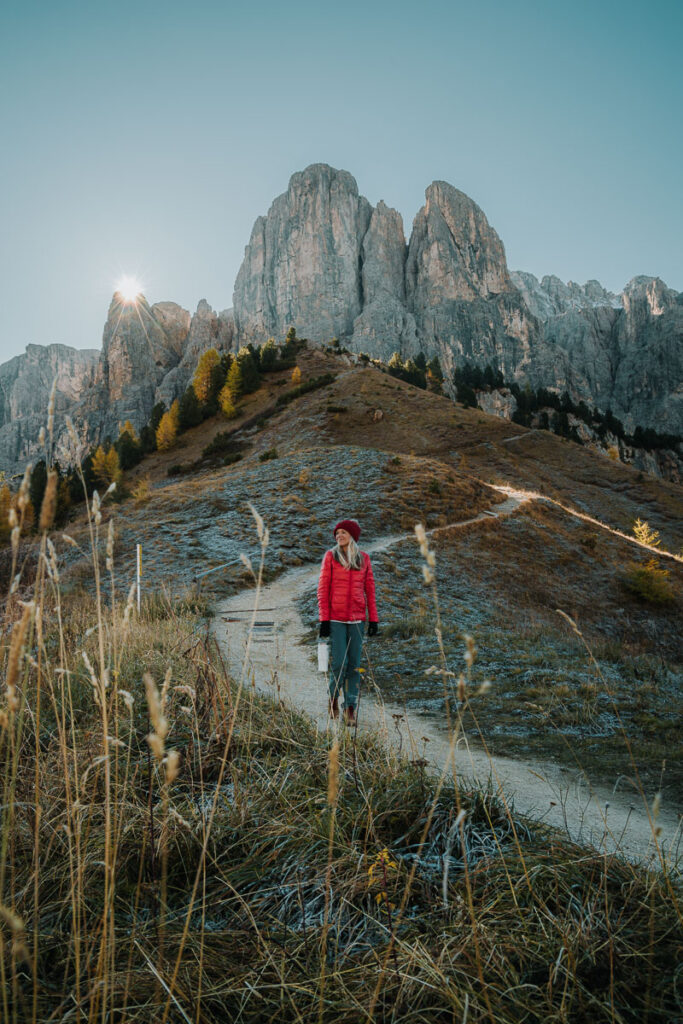
For sunrise, I recommend stopping at Rifugio Frara where you can park and reach an epic view of the Sella mountains.
This pass is beautiful both at sunrise and sunset, but if you are using my Dolomites road trip itinerary then I recommend stopping here for sunrise, so you can explore more places the rest of the day.
Stop 2: Lago di Landro
This is a beautiful lake that is right along the road. You barely even have to walk to get to it. Lago means lake and as you will see there are tons of lakes in the Dolomites region that you can stop at. Some require a hike, others are right off the road.
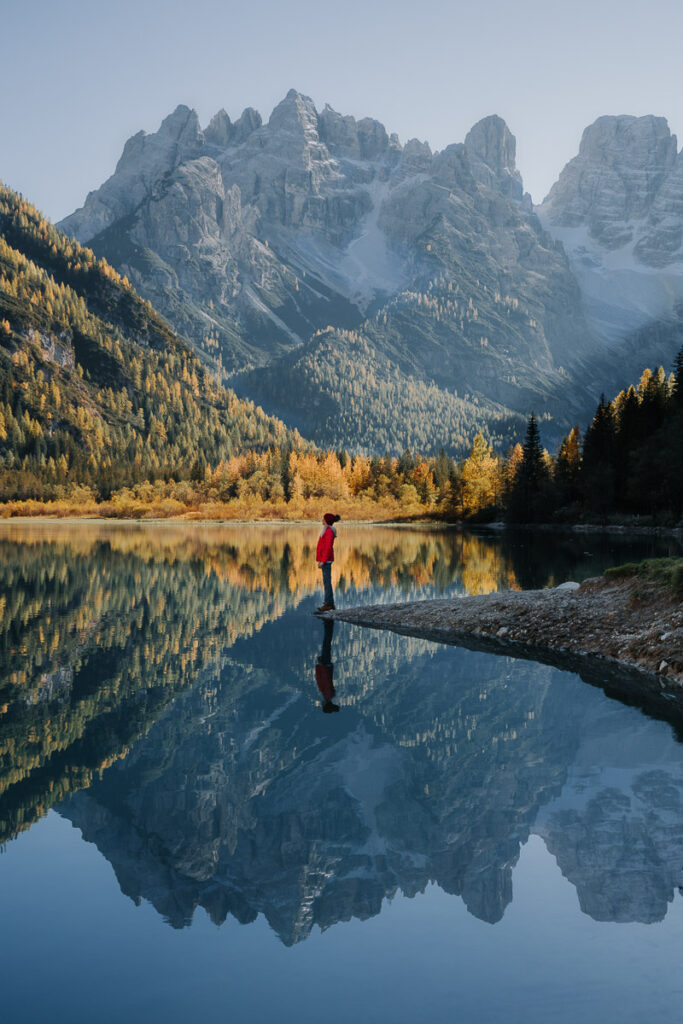
This is of course another beautiful lake. There is a trail that you can walk around the lake here if time permits.
Stop 2: Lake Misurina
For sunset, we chose to go to Lake Misurina. There is a beautiful path along the lake that you can walk around as well. If it is cold, grab a cup of hot tea from the cafe right on the lake. In the summertime, you can also rent canoes and paddle out on this lake.
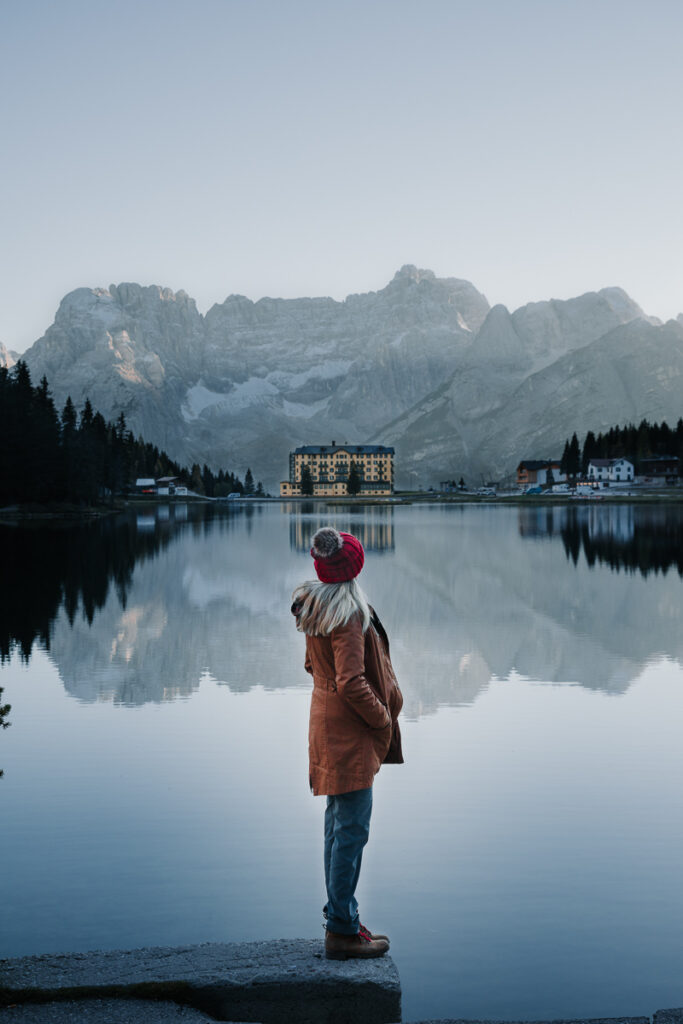
Optional stop: Lago di Sorapis
Instead of visiting the two lakes above, you could hike to Lago di Sorapis this day. We were pretty tired from our hike yesterday and waking up early this morning (plus being pregnant) so we decided to make today a bit slower.
This looks like a gorgeous hike and one day I plan to go back to visit, but for now, check out this article that gives you all the details on hiking here.
Your accommodations for the next few nights will be in the town of Cortina d’Ampezzo. Stay at: Chalet Falorie Airbnb 2BR 2BA – $527 Total for 2 nights
DAY 4 OF YOUR DOLOMITES ROAD TRIP
Today we decided to focus on some photography, so we chose a sunrise location and a sunset location for the day. In the middle of the day, we chose to head back to our Airbnb nap and edit some photos.
Stop 1: Lago di Antorno
Yet another beautiful lake that is right off the side of the road. We chose to go here for sunrise and were blessed with some insane colors. It was freezing in the morning, so make sure to dress appropriately.
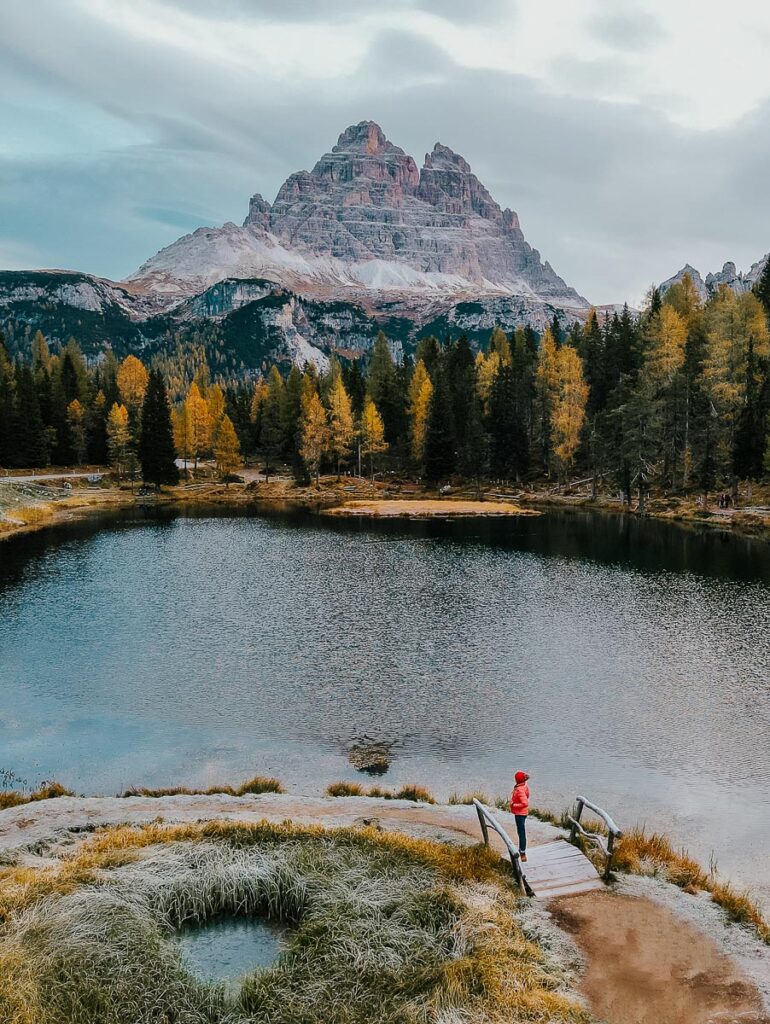
Stop 2: Candini di Misurina
For sunset tonight you will be hiking around the Tre Cime de Lavaredo area. You will be doing the hike to Candini di Misurina; however, if you don’t want to relax in the middle of the day as we did then you could add on the Tre Cime de Lavaredo loop hike.
The Tre Cime de Lavaredo loop hike is a 10km loop that I have heard is fairly easy. On this hike, you will see the three iconic peaks you probably see in a lot of photos. This hike as well as the Cadini di Misurina hike begins and finishes at Rifugio Auronzo. The Tre Cime de Lavaredo loop is best done counterclockwise
You will find multiple parking lots at this Rifugio; however, to get here you will need to pay 30 EUR to enter this park. It takes about 40 minutes to get here from Cortina d’Ampezzo.
If you don’t want to do this loop then I recommend the short hike to Cadini di Misurina. Personally, I think this location is more stunning and the hike is shorter. A win-win.
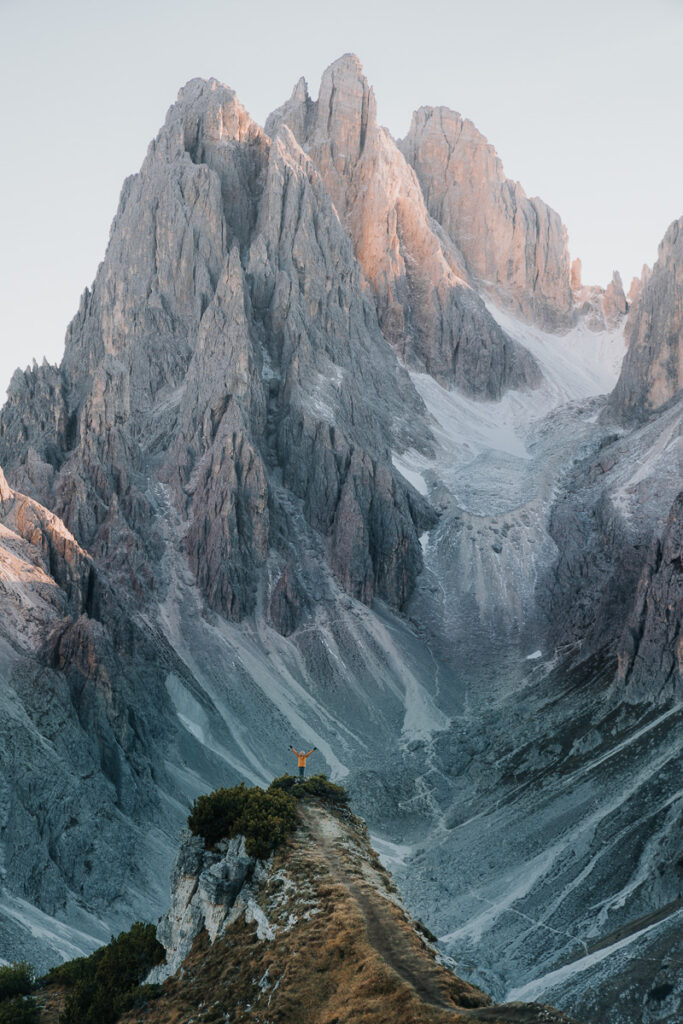
To get to this location, you will hike in the opposite direction of Tre Cime. You can check out my Youtube video for exact directions and what it looks like as it can be a bit confusing. Essentially look for signs marked trail 117. The path is a little discreet.
If you are afraid of heights this path may not be for you as it is narrow and there are some steep drop-offs, but it is beautiful once you reach the endpoint.
This place is truly awe-inspiring. It took us about 30 minutes to get here, it was an easy hike and we almost had the place to ourselves. It is a great location for sunset too! Just bring headlamps for your hike back out.
DAY 5 OF YOUR DOLOMITES ROAD TRIP
Your final day exploring the Dolomites! And maybe my most favorite location on this entire list. Today you will be visiting Lago Di Braies for sunrise.
Stop 1: Lago Di Braies
If you are staying in the town of Cortina d’Ampezzo then it will be about a 50-minute drive from here. I highly recommend arriving here before sunrise as the parking lot does fill up. This is one of the most popular lakes to photograph.
You will find tons of photographers here so if you want to get a good spot you will need to arrive early.
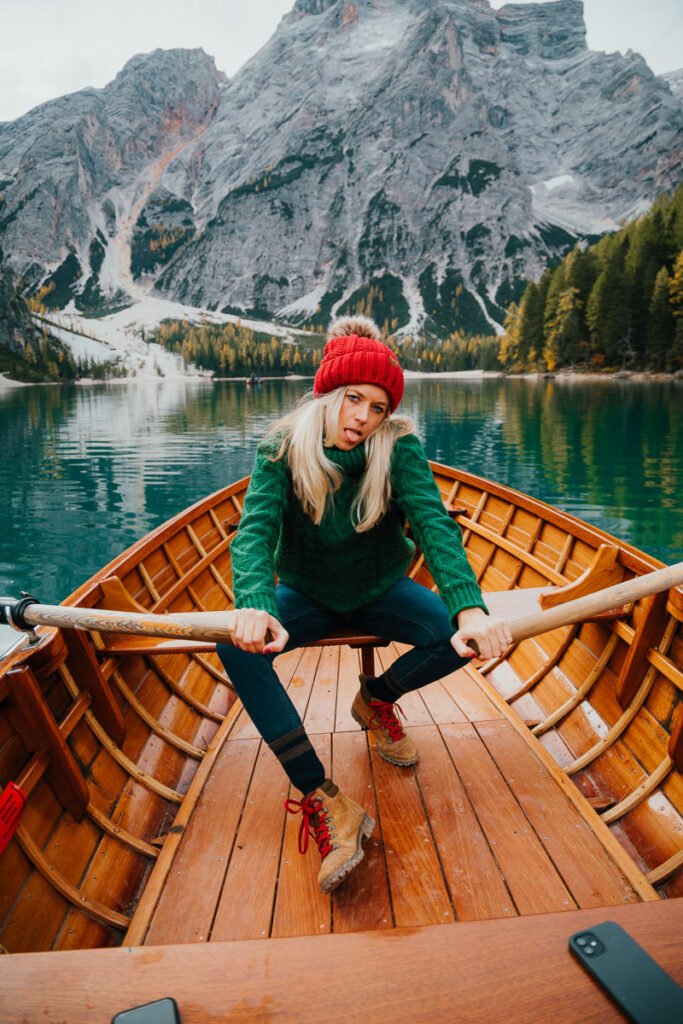
While here you can take a walk on the trail that goes around the whole lake or you can rent a rowboat to go out on the lake. I highly recommend renting one. Personally, I thought it was fun, romantic, and worth the photos.
The boathouse opens around 930am and costs €25 EUR for one hour, €15 EUR for every 30 minutes after that. The line did get really long, so again this is why I recommend arriving early.
If you get cold while waiting for the rowboats to open there is a little cafe within walking distance of the lake where you can grab some hot chocolate, coffee, and breakfast.
After you finish your time at Lago Di Braies it will be time to return to your starting point. For us, this meant driving back to the Venice airport and returning our rental car.
DOLOMITES PACKING GUIDE
If you are planning to visit in the Fall, prepare yourself for cold weather. The brisk air at these altitudes in the mountains will get ya. Below I have listed out some of my favorite gear to keep me warm.
It is always important to start with a base layer. When purchasing a baselayer you want to find something that is made out of Merino Wool as this will help wick away any moisture. Avoid cotton. My favorite long sleeve base layer tops and bottoms are from Kari Traa . It is important to have a top and bottom base layer.
[show_shopthepost_widget id=”4664809″]
A mid-layer is another important piece to layering to keep you warm. Kari Traa again offers a great pullover as a mid-layer option. The Patagonia Los Gatos ¼ zip is another one of my favorites. I have it in brown.
[show_shopthepost_widget id=”4664812″]
OUTER LAYER
Your outer layer is extremely important for those bitterly cold days. I would ensure you bring a thicker coat as well as a waterproof layer. For a longer layer, I have the Sundowner Jacket from KAVU . For my waterproof layer, I went with the Marmot Precip Eco Jacket . Lastly, for extra warmth, I love my Arc’teryx Cerium LT Hooded Down Jacket.
[show_shopthepost_widget id=”4664819″]
My favorite boot that you can hike in or just walk around town in is the Blundstone Classic 550 Chelsea boot . If you are looking for a sturdier boot, then I recommend the waterproof Danner Addrika Hiking Boot . And if you don’t like the ankle support then I recommend the KEEN Voyageur Hiking Shoe .
[show_shopthepost_widget id=”4664825″]
ACCESSORIES
These are some of my favorite must-have accessories to keep me warm while on the trails. My hands always get cold so I purchased these iphone compatible Icebreaker Sierra Gloves . Of course, you need to keep your ears warm. I have found the ultimate beanie that keeps you warm in the winter. And lastly, this has become my favorite day hiking backpack that is affordable and can fit everything you need in it for the day.
[show_shopthepost_widget id=”4664823″]
FINAL THOUGHTS FROM YOUR OUTDOOR LOVING GIRL
As always, never forget to follow the Leave no trace principles, so that we can leave the Dolomites a better place for the next people to visit. I hope you found this Dolomites road trip itinerary helpful for planning.
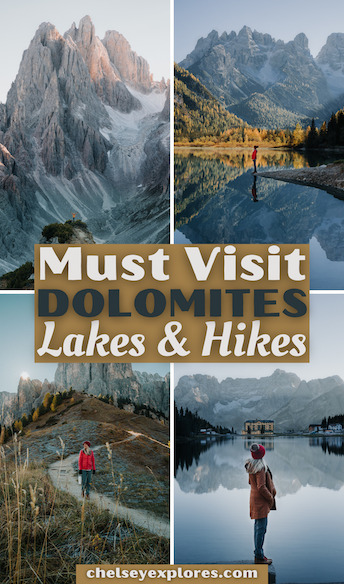
Similar Posts
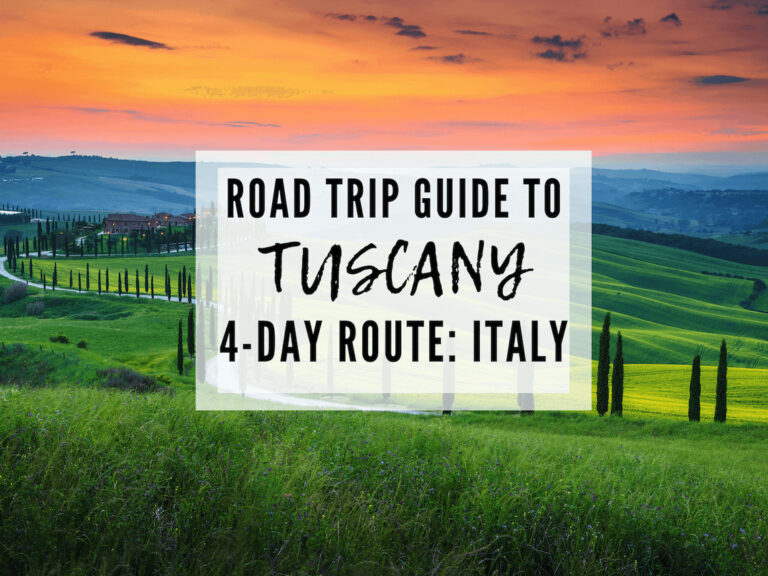
The most epic Tuscany Road Trip Itinerary
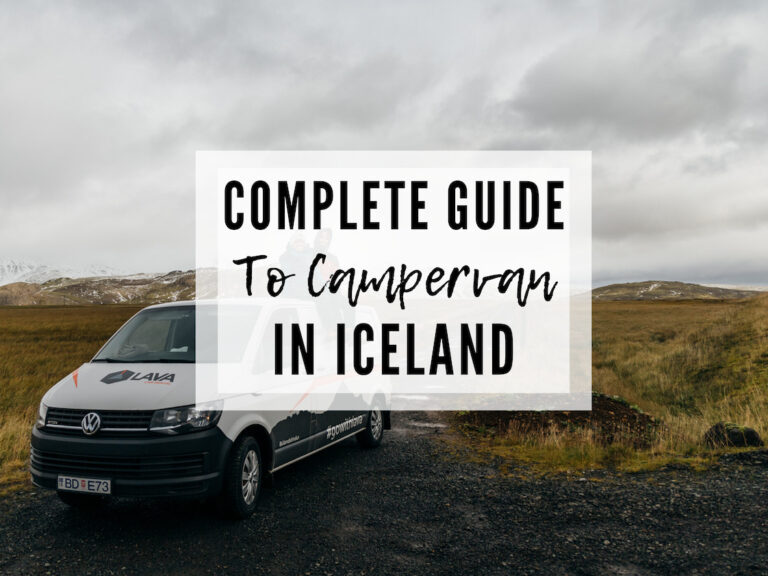
How to Campervan in Iceland with LAVA car rental
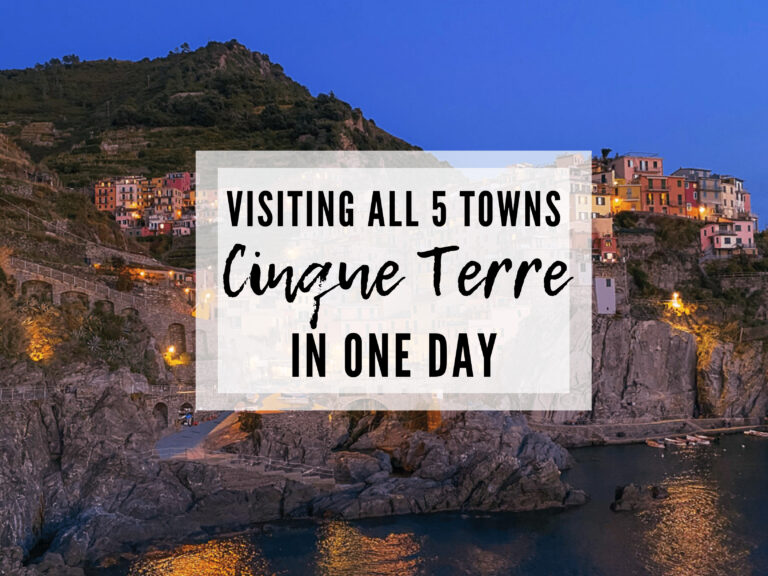
The Perfect 1 Day in Cinque Terre Itinerary
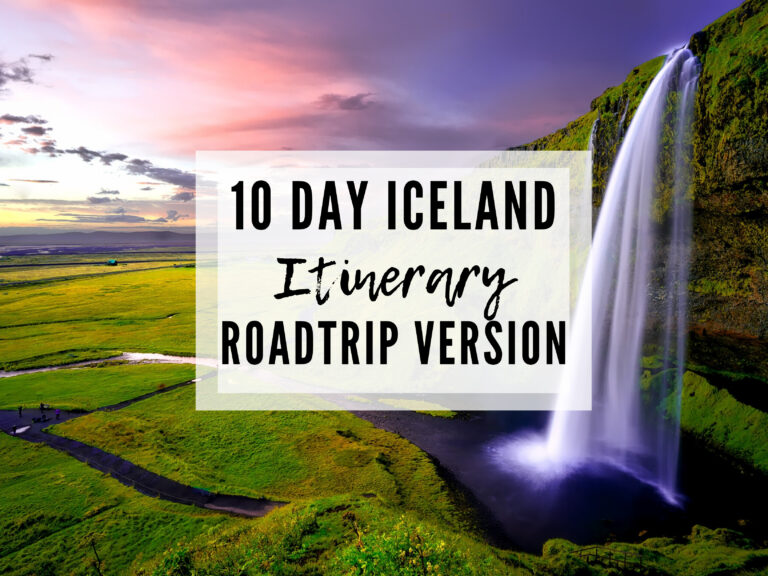
THE ULTIMATE 10 DAY ICELAND ROAD TRIP ITINERARY
Leave a reply cancel reply.
Your email address will not be published. Required fields are marked *
Taking the train in Spain - all you need to know

Apr 3, 2024 • 15 min read
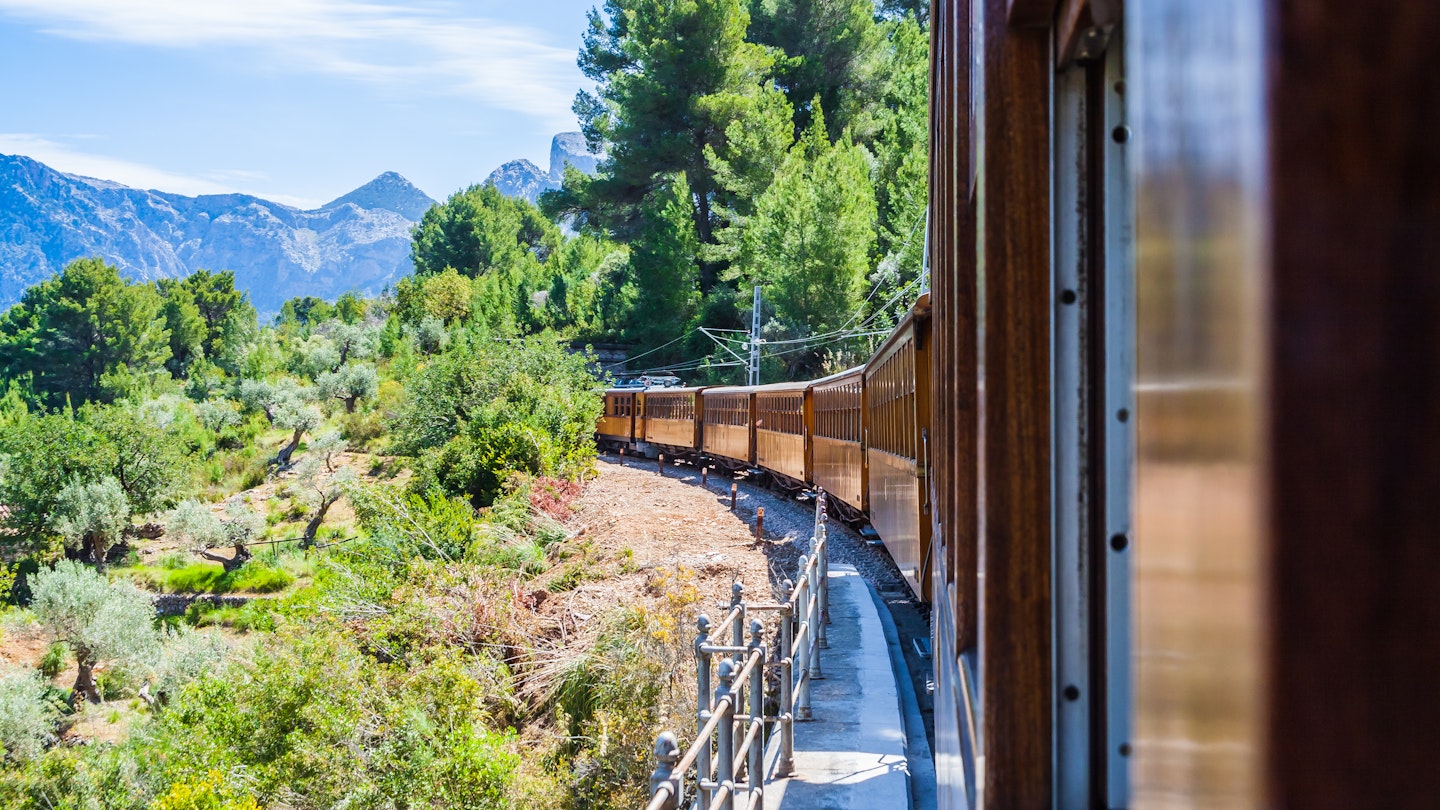
The vintage train from Sóller to Palma de Mallorca is one of the most scenic rail routes in Spain © Shutterstock
Spain boasts Europe’s longest high-speed rail network, second only to China globally, and its trains are exceptional and far-reaching. In one day, you could gawp at Gaudí’s architectural genius in Barcelona , be whisked by rail to Madrid ’s museums, and still arrive in Seville for a sunset flamenco show.
Not that it’s all A to B whirlwind rail routes. There are some outstanding scenic train journeys to slow down and enjoy the Spanish pace of life, whether trundling along the northern coast’s narrow-gauge tracks or meandering into the mountains. And with some new low-cost operators now on the scene, exploring Spain by train has never been more affordable.
With over a thousand stations and thousands more daily departures, getting around Spain by train is a straightforward joy rather than a stressful necessity. Seat reservations on most services guarantee uncrowded carriages, Rioja-serving cafe cars provide perfectly wine-paired panoramic views, and electric-powered trains make journeys even more sustainable. What’s not to love? Here’s everything you need to know to plan a train trip in Spain like a pro.
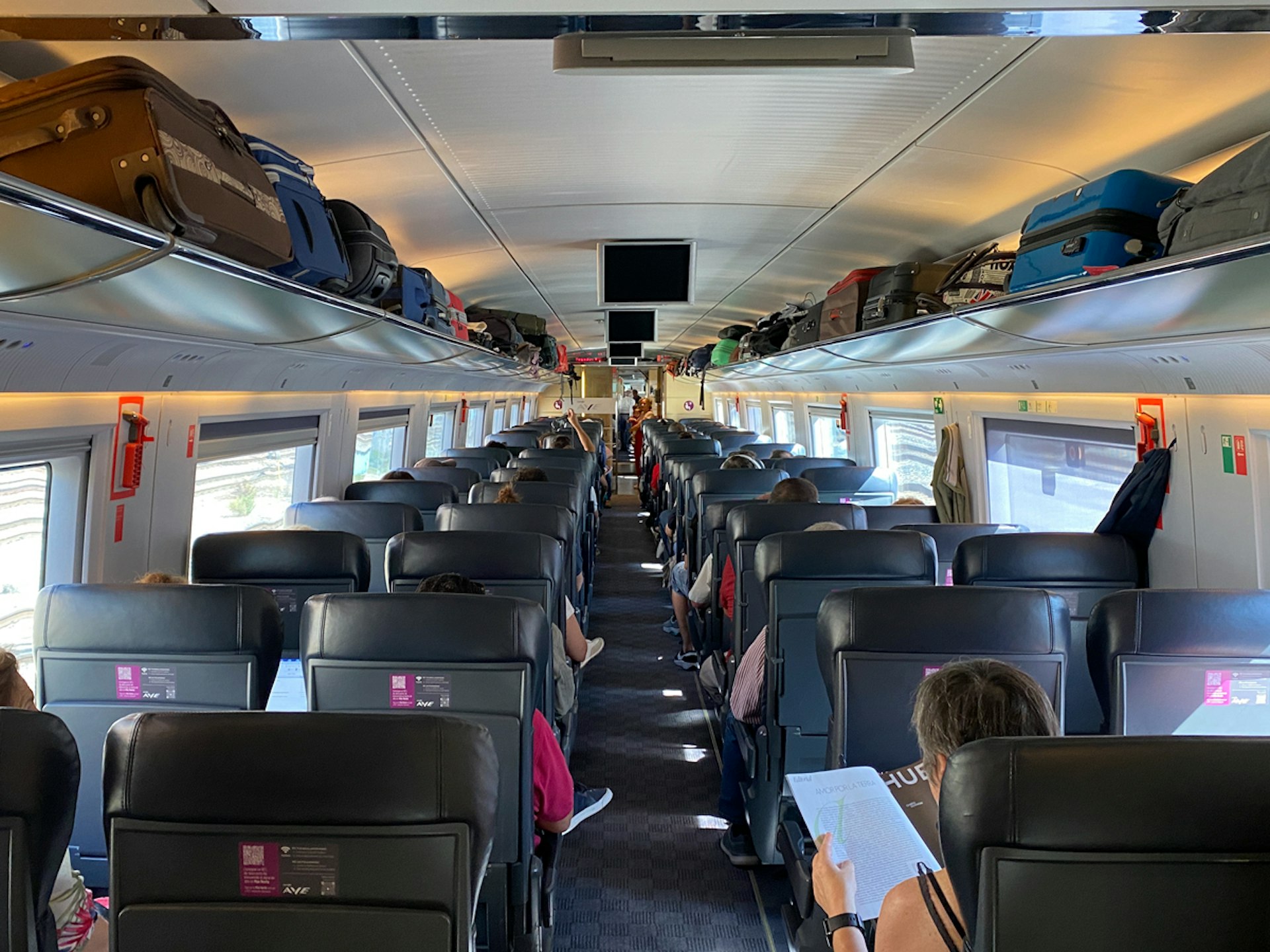
Train services are generally excellent in mainland Spain
You can traverse all four corners of Spain by train, usually on swift, reliable, well-maintained carriages. Few areas aren’t covered by at least a regional service. And where there are coverage gaps, buses will usually take you the final stretch to that pretty medieval village. While strikes can occur, they are rare, and minimum service levels are generally guaranteed. Compensation payments are offered for delays over one hour, which helps keep timetables on track.
Renfe is Spain’s national railway company, operating everything from non-stop regional capital connections to short-hop commuter services. Iryo and Ouigo provide low-cost competition on the main high-speed intercity lines, with the latter’s double-decker trains being a welcome addition.
While the numerous names for differing service and train types can be confusing, the trains in Spain can generally be divided into three categories:
- High-speed, mainly long-distance (larga distancia) services link many major cities, mainly via Madrid. These full-service trains can reach 310km/h (193mph) and include Renfe’s AVE (Alta Velocidad Española), its new no-frills Avlo counterpart, and Iryo and Ouigo. There’s an ever-growing network of high-speed routes , including the popular Barcelona–Madrid, Madrid–Seville, and Madrid–Valencia lines.
- Mid-distance services – although they can sometimes cover long distances and reach speeds of 250km/h (155mph) – make up the majority of other major routes. Renfe services these under names including Media Distancia, Avant and Alvia. Intercity and Regional Exprés services are somewhat slower but only call at major stations. Popular routes include Madrid– Toledo , Granada–Seville, and the Euromed coastal service between Barcelona and Alicante . Nearly all long and mid-distance services use sleek, modern carriages.
- Slower trains , including Regional, Proximidad, and Cercanías commuter services (Rodalies in Catalonia), complete the network. The older Cercanías AM trains, previously FEVE, mainly operate on the northern coast’s picturesque narrow-gauge tracks.
Nearly all large and medium-sized train stations are staffed and contain shops or cafes. High-speed train stations operate similarly to airports, with luggage security scanners and boarding gates. It’s advisable to arrive 20–30 minutes early, especially as boarding can close five minutes before departure. The bonus is you’ll have time to admire the stations. Some, like Toledo’s Mudejar-style ticket hall and art nouveau Bilbao Concordia , are attractions in their own right.
There are tourist trains and unique rail services too
In addition to standard train services, Spain has an exceptional selection of specialist rail routes known as “ tourist trains .” These range from seasonal, short routes, such as the scenic Tren dels Llacs in the Pre-Pyrenees, to indulgent, multiday sojourns like the luxury Transcantábrico train hotel. There are currently no standard domestic night trains.
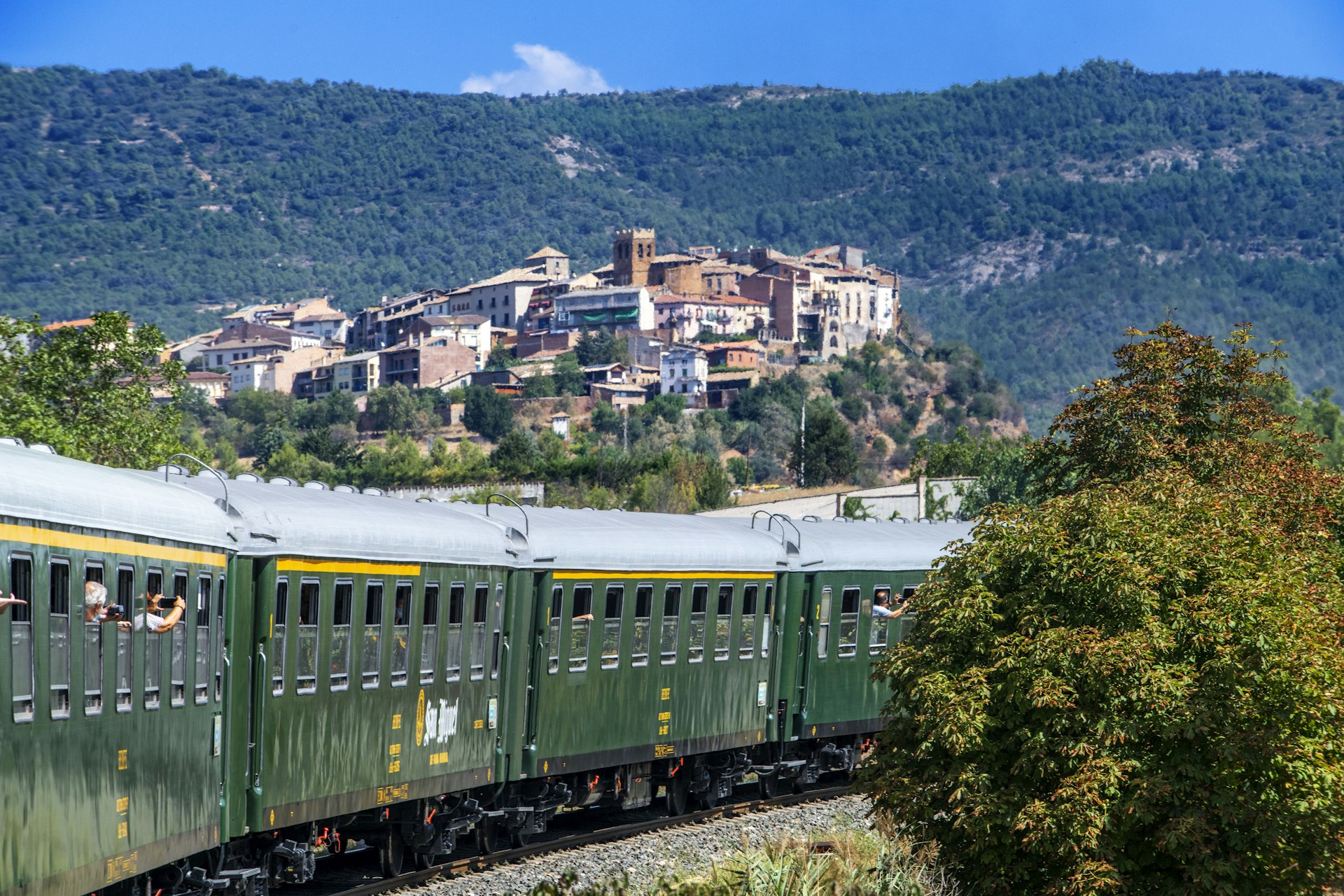
International and island rail routes are limited
Away from the mainland, the rail situation is starkly different. The Canary Islands have no train services, and only Mallorca in the Balearic Islands has limited rail connections . These consist of three short, modern lines and the vintage Sóller train.
Traveling to and from France by train is possible on France’s TGVs (from Paris) and Renfe’s International AVE services to Marseille and Lyon . Fares start from €29. You can also cross via Hendaye in the Basque Country or take the slower, scenic sleeper service via the Pyrenees . The Trenhotel (night service) between Madrid and Lisbon has been discontinued, leaving the Tren Celta between Vigo and Porto and the slow route to Lisbon via Badajoz as the only connections with Portugal . Work continues on improving the tracks to accommodate a direct, high-speed link between the two Iberian capitals.
Book ahead to save money and guarantee your seat
Spain’s rail operators all use dynamic pricing for high-speed and long-distance services. Therefore, early booking is advised, especially as seat reservations are mandatory. Advanced Avlo tickets between Madrid and Barcelona start from €7, with Ouigo and Iryo also offering competitive pricing on primary routes. A same-day ticket can sometimes cost more than 10 times more than booking in advance. Prices are less competitive on routes solely operated by Renfe.
When booking tickets online to or from major cities, use the dropdown city name followed by todos (all) to check for direct and affordable tickets from all stations. Provide the Passport or ID number of the photo document you’ll be traveling with, as tickets are personal. The second surname can be left blank – Spanish people take both their father's and mother’s surnames. Tickets can be printed, collected at self-service machines, or displayed as QR codes on mobile devices. Overall, Ouigo and Iryo's websites are easier to navigate than Renfe's, which can be glitchy. While most people would recommend using a third-party booking service – handy for comparing prices between all operators – direct reservations avoid booking fees.
Even short-distance, popular services with fixed fares (some mid-distance and regional trains) can fill up. I’ve previously struggled to get last-minute weekend tickets on the Madrid to Toledo route. Secure all tickets ahead if your vacation coincides with a major holiday such as Easter (Semana Santa) or Christmas, including around Three Kings Day on January 6.
Iryo and Ouigo release tickets many months ahead. Renfe’s tickets should be available at least 60 days ahead, but this isn’t always true. Check regularly in the months leading up to your departure and sign up for newsletters on the three websites to receive ticket availability and discount updates.
Occasionally, two single fares (ida) can be cheaper than a return (vuelta) . Reservations can also be made at station ticket machines (in English) or staffed desks. Larger stations may have separate sales points for particular types of tickets.
You’ll always be assigned a mandatory seat reservation. However, if you’d prefer to select your own to guarantee a window, you can change it for a nominal fee. Confusingly, Renfe’s website has this step after choosing a payment method.
Cercanías and Cercanías AM tickets can’t be purchased in advance and should be purchased at the ticket office, self-service machine, or onboard from the conductor when traveling from the tiniest unstaffed stations. This is the only time you’re allowed to board a train without a ticket.
If you wish to upgrade from basic class (básico) on high-speed routes, you can choose from Elige, Elige Confort and Prêmium on Renfe, or similar options on Iryo. Upgrades can include access to premium station lounges, at-seat food service, and more spacious seats. Solo travelers may want to upgrade to enjoy an individual seat in the 2+1 configured carriages. Ouigo allows these seats as a paid add-on without upgrading.
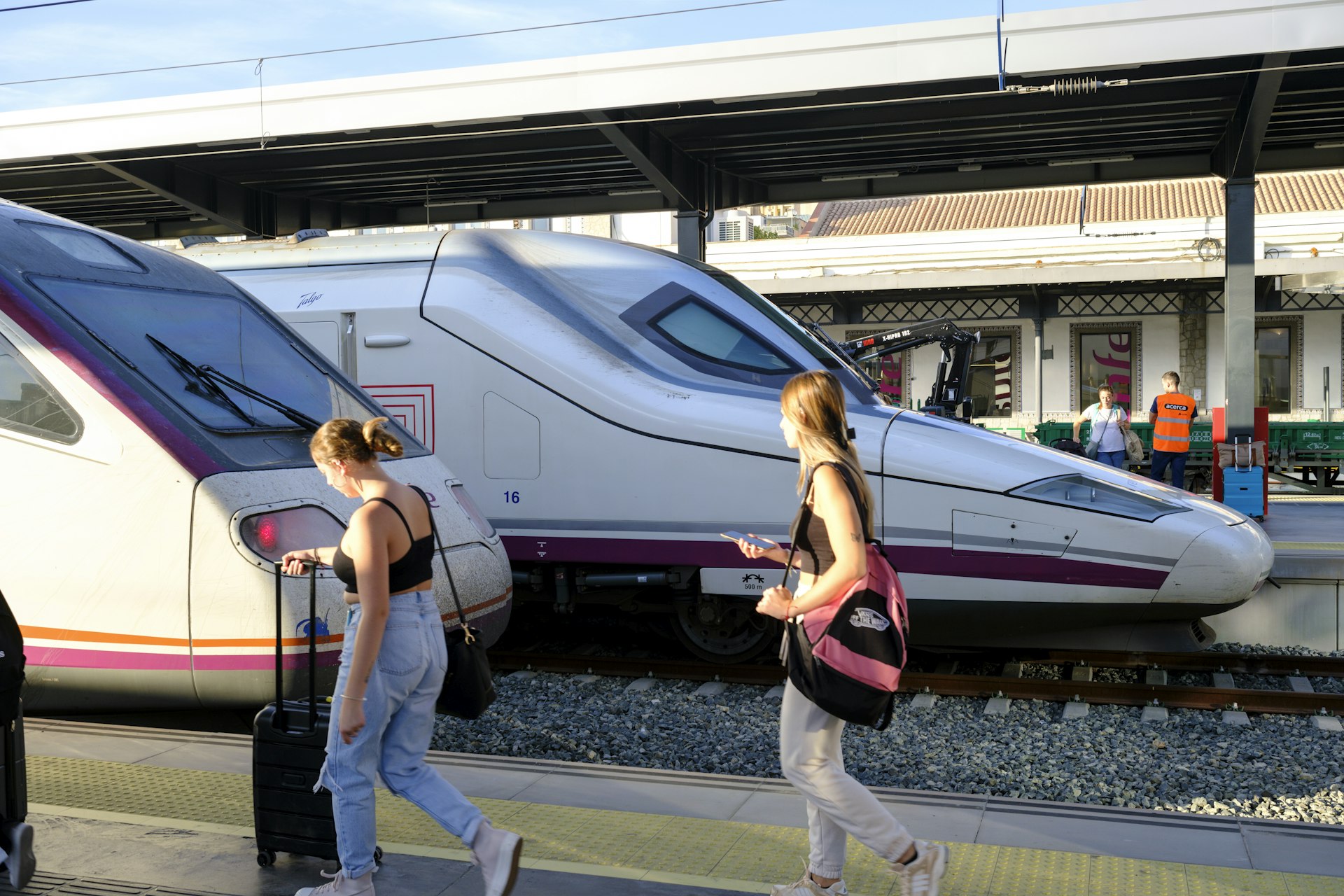
Discounts and offers: know your benefits and bring ID
Much noise was made about the launch of Spain’s fixed-price travel pass . Yet this system, established to offer discounted fares on repeat return trips, is primarily aimed at locals and commuters.
Renfe does offer a Spain Rail Pass for travelers , covering between four and ten journeys. However, depending on the routes you plan to take, pre-booking discounted, advanced fares can be cheaper. Some region-specific options exist, such as the better value three-day Galica Rail Pass .
Other discounts available on Renfe include:
- Small group discount when booking four or more travelers together.
- Seniors discount, up to 40%, for over 60s. However, this requires purchasing a card ( La Tarjeta Dorada ) in person before making the reservation. Advanced, discounted fares can be better value.
- Youth Discounts for under 25s with a European Youth Card or suitable International Student Card. A digital card can be purchased online by citizens of most countries.
- Babies travel for free, as do children, although the age cap varies between operators.
Considering an Interrail or Eurail pass? Check on any savings first. All high-speed trains in Spain require seat reservations, an additional cost not included in these passes. Avlo, Iryo, and Ouigo are likewise excluded, and these cheaper advanced tickets may be better value than using the pass, though there is less flexibility.
Money-saving tip: high-speed trains include a free local ticket
If you’re traveling on a high-speed AVE or long-distance service operated by Renfe or Iryo, Combinado Cercanías is included. This allows for free use of local Cercanías trains to reach your departure station and again on arrival. Scan the QR code at barriers, or use the PDF code to get a zero-priced ticket at Cercanías’ self-service machines.
Seat reservations ensure most train journeys don’t feel crowded
Traveling by train in Spain is so enjoyable because all long and mid-distance services require a seat reservation. With no congested corridors or jostling vestibules, these trains never feel crowded, even when full. However, some regional and Cercanías services can be packed, particularly around commuter hours and Friday and Sunday evenings. You might want to avoid peak times or, when available, pay for a regional service seat reservation.
Plan around major events and regional holidays during your trip, such as Semana Santa, when ticket demand and crammed suburban trains are common. Trains in Spain operate every day of the year, though some services may finish earlier on public holidays. If you’re traveling on weekends or during holidays, check onward public transport in advance as small, rural stations may have a reduced weekend bus service.
Train can be the fastest, most affordable transport method
Using the train in Spain can be quicker and cheaper than flying. For example, a flight from Madrid to Barcelona takes 1¼ hours compared with 2½ hours by high-speed rail. But once you factor in security checks, out-of-city airport transfers, and runway taxi times, the overall journey length by plane becomes longer.
Driving distances are considerable. The same journey by car will take closer to seven hours. It’s unquestionably worth renting a car if you’re planning a road trip , but generally, long-distance jaunts are best by rail.
Most train terminuses are connected to city buses and, in larger metropolises, commuter rail or metro systems. Barcelona-El Prat Airport and Madrid–Barajas Airport are on the train network. If you wish to visit smaller towns or villages that are not on the train network, consider other ways to get around Spain .

Onboard facilities differ between service types
All of Spain’s high-speed train services are spacious, comfortable, clean and well cared for. Carry-on luggage can be placed in overhead racks, while storage areas at either end of the carriage accommodate bulkier luggage. Popular services (especially on Friday and Sunday evenings) can quickly fill, and train staff will usually assist in rearranging suitcases to fit. Cercanías services can be more dated and crowded and often lack enough dedicated luggage space.
If you’re traveling by bicycle, check the luggage policies of Renfe and Iryo . In some instances, bikes must be disassembled or an additional fee paid.
The dining carts on Spain’s trains are typically stand-up, cafe-style rather than seated dining carriages. They’re good for stretching your legs or getting an alternative window view, but dining at your seat table is often more comfortable. A selection of hot meals, snacks and drinks – usually all of decent quality – are available, and certain ticket types offer pre-ordered meals served at your seat. Iryo has particularly impressive dining options .
On some routes, a trolley service may be provided in addition or as an alternative. Mid-distance and Avlo services have vending machines rather than dining carts. Bringing your own food and even alcohol onboard Renfe’s services isn’t a problem.
Complimentary (sometimes patchy) wi-fi is provided on Iryo and Renfe’s high-speed services, alongside entertainment portals accessible on your device. Ouigo charges per connection. Plug sockets (F-type) are available at seats on high-speed and mid-distance trains. Nearly all trains, except commuter services, have toilets.
Plan the perfect train trip with these scenic routes and tips
The most popular train routes for travelers in Spain are the high-speed connections that rocket between Seville, Madrid, Barcelona and Valencia. But riding the rails in Spain isn’t only about barrelling between urban sprawl. These are some of our favorite scenic rail routes worth planning into your trip.
- Santander to Oviedo : Cross the lush landscapes of Northern Spain on this slow, scenic rail route using Cercanías AM’s narrow-gauge tracks. This six-hour journey provides some of the expensive Transcantábrico Train’s panoramas for a bargain €16.55. There are no seat reservations, which is handy, as you can switch sides to marvel at both the sparkling Bay of Biscay and the mighty Cantabrian Mountains , Spain’s answer to the Dolomites.
- Barcelona to A Coruña : Once served by the discontinued sleeper Trenhotel, this is one of Spain’s longest rail routes, taking nearly 14 hours. The 9:05am Alvia departure can be affordable to cross seven of Spain’s autonomous communities. Pack snacks and pay for a window seat (ideally on the right) to see the full scope of Spain’s landscapes, from arid pastures and fertile farmlands to the verdant Galician Massif . Consider hopping off a few stops early in Ourense to use the town’s free-to-access thermal pools the following morning.
- Granada to Almería : Leaving the magnificent Moorish Alhambra behind, set off across western Andalucía towards the coastal city of Almería. It’s a showstopping three-hour journey traversing the foothills of the Sierra Nevada, snow-capped peaks looming beyond, before cutting through carpets of cork trees. Book a late afternoon departure for ethereal golden light, or take two single tickets to plan a lunch pause at Guadix, best known for its cave houses.
- Palma de Mallorca to Sóller: Step onboard the rickety, wooden carriage of Ferrocarril de Sóller , constructed in 1912, for a one-hour-long trundle from Mallorca's capital to the pretty port town of Sóller. En route, you’ll wend through the Tramuntana Mountains, unlit tunnels, and citrus groves close enough to touch. All seats are excellent, but you might want to stand in the open-air platforms between carriages.
- Zaragoza to Canfranc : A one-way ticket on this twice-a-day, 2½-hour regional train costs just €16.90, and you’ll get plenty of panoramas for your money, especially after Huesca when the tracks slowly climb up into the Pyrenees. Our resident rail expert, Tom Hall, calls it one of Europe’s best train routes , partly because the landmark Canfranc Station has recently been reborn as a grandiose hotel .

Station tips when traveling Spain by train
Most large cities have multiple train stations, so always confirm departure points. When traveling to dedicated AVE stations outside major cities, check the station’s distance from the city center and pre-plan your connecting travel. Some stations, such as Antequera ’s Santa Ana, can be as far as 15km (9 miles) from the Old Town.
Spain’s largest stations, such as Madrid Atocha and Barcelona Sants, can be confusing due to split-level and separated boarding areas for different services. Don’t be afraid to ask for help navigating the station. A quick flash of your ticket will soon have you pointed in the right direction.
All major stations have cafes and kiosks where you can pick up food, although preparing a train picnic from a delicatessen might be preferable. Still, a quick tapas in Atocha's Tropical Garden, even if the pond-residing turtles have now been rehomed, is a solid start to any journey. If you’re on a connecting service with time to explore beyond the station, most larger terminals have lockers or left luggage desks (consigna) .
Many stations are accessible, but there’s room for improvement on older services
Adif, the agency in charge of Spain’s rail infrastructure, provides in-station and boarding assistance for travelers with accessibility needs via the Acerca service, offered at 145 stations.
When booking tickets online, H seats – accessible spaces that can anchor a wheelchair – can be requested on the opening screen, and Acerca assistance can be requested later in the booking process. A minimum of 12–48 hours' notice is stipulated, depending on the operator. However, in larger stations, staffed service centers can usually provide support without pre-booking if you arrive and register at the desk ahead of travel. Check which facilities are available at each station on Adif’s website .
In addition to offering boarding support (many train types require a stair-climber lift, not just a ramp, while others like Avlo have level boarding), Acerca can provide technical aids for hearing and a guided sight service. Contact Adif Acerca for information on induction loop systems or to discuss alternative routes should your planned journey include a non-accessible station without in-person assistance. Tactile paving, step-free access, and elevators are installed at most major stations, and nearly every train has a conductor or staff member onboard who can assist.
On high-speed, long-distance, and most other services, wheelchair-accessible bathrooms are located in carriages with H seats. Ouigo trains have a call button on adapted seats to provide food and drink service, as the cafe is located on the top deck. Cercanías AM carriages have no H seats but offer a dedicated space for wheelchair users with tie-downs. However, many older, narrow-gauge trains lack accessible bathrooms.
Explore related stories
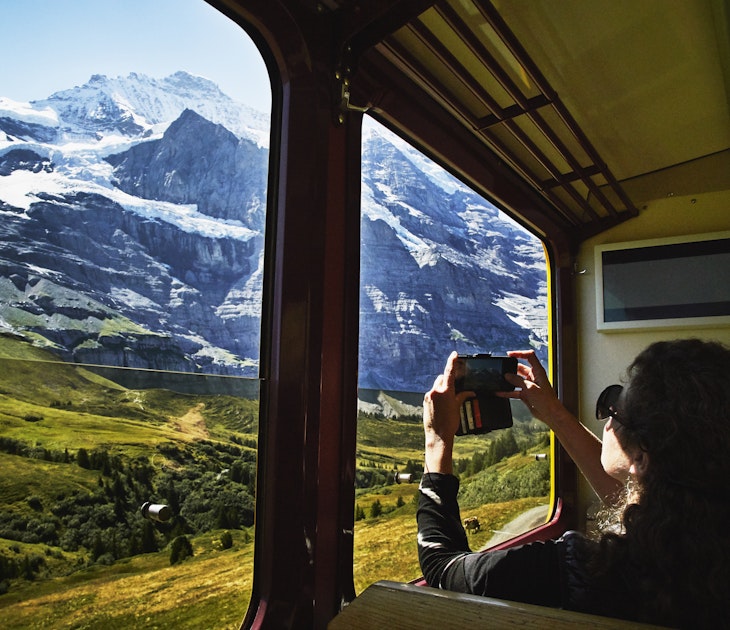
Sustainable Travel
Jan 16, 2024 • 8 min read
Rolling forests, saw-toothed mountains, bridges spanning river gorges - these European train rides put on quite a show.
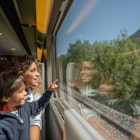
Dec 25, 2023 • 11 min read

Dec 19, 2023 • 6 min read

Nov 1, 2023 • 4 min read

Oct 19, 2023 • 8 min read

Oct 6, 2023 • 8 min read
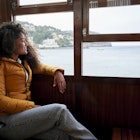
Jun 26, 2023 • 5 min read

Jun 18, 2023 • 6 min read

May 19, 2023 • 12 min read
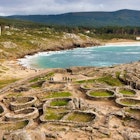
May 5, 2023 • 7 min read

IMAGES
VIDEO
COMMENTS
It was recognised as a UNESCO World Heritage site in 2009. Encompassing an area of 141,903 hectares and 18 peaks which rise to above 3,000 metres, 'The Dolomites' stretch across three Italian regions (Veneto, Trentino-Alto Adige / Südtirol (South Tyrol), and Friuli Venezia Giulia).
This guide covers our recommended itinerary for spending one week in the Dolomites, structured so you can enjoy some excellent hiking with rest days in beautiful locations. DAY 1 - PASSO PARDOI. DAY 2 - TRE CIME. DAY 3 - BRAIES & FUNES. DAY 4 - ALPE DI SIUSI.
The Dolomites also offer some of the most incredible mountain scenery in Europe, with 18 peaks rising more than 10,000 feet. Dolomitic limestone forms the mountains' peaks, which rise dramatically ...
This ultimate Dolomites road trip guide should show you why visiting South Tyrol was our favorite trip to date. I've bookmarked images from the Dolomites for years now and I have to say, the photos do not do it justice. It's hard to describe how otherworldly this outdoor haven is in person. After deciding on a 9-day road trip through the ...
Italy's Dolomites Region: The Complete Guide. A favorite destination of nature lovers, the Dolomites, or Dolomiti in Italian, is a mountainous region that is part of the Northern Italian Alps. Dominated by 18 majestic peaks, its diverse landscape consists of more than 350,000 acres of jagged pinnacles, sheer rock faces, icy glaciers, deep ...
Dolomites Travel Guide. The Dolomites are a massive mountain range in the Italian Alps in northeastern Italy, stretching across the regions of Trentino-Alto Adige, Veneto, and Friuli Venezia Giulia. In 2009, these mountains were listed as a UNESCO World Heritage Site covering a total area of 141,903 hectares.. The Italian Dolomites are without a question one of the most dramatic alpine ...
Once we arrived at the airport, we rented a car and drove for 3.5 hours to the Dolomites region. After much research, we went with Budget car rentals and chose a small SUV for our Dolomites road trip. The final cost came out to around $500 for 5 days of a car rental. Tip: European cars tend to have smaller trunks than American cars.
The Dolomites cover an area of around 140,000 hectares. The mountain range is roughly 250 kilometres long and 100 kilometres wide with a total of 18 peaks above 3,000 metres in altitude. The area can be divided into 3 distinct regions, each with its own unique landscape. LAYOUT | REGIONS OF THE ITALIAN DOLOMITES.
Day 3: Hiking at the Seceda ridgeline, driving through Passo Gardena, and arriving at La Villa or Cortina d'Ampezzo. Day 4: Renting a boat at Lago di Braies, hiking to Lago di Limides and visiting Lago di Valparola. Day 5: Hiking around Tre Cime di Lavaredo, hiking to Cadini di Misurina.
Discover our definitive 7-day Dolomites road trip itinerary. Uncover the best of this stunning Italian region, including major sights and attractions, best day hikes, and where to eat, as well as all the essential travel information you need. After two trips to its jagged peaks, emerald lakes, verdant meadows, and quaint towns, we're utterly ...
The Ultimate Travel Guide to Dolomites Best Time to Visit the Dolomites. The Dolomites are an attractive destination all year round, but the best time to visit largely depends on your preferred activities. If you're a hiking or mountaineering enthusiast, the most favorable period is from June to September when the weather is typically warm ...
Our Dolomites travel guide is filled with everything you need to know before you visit, including what to see and do, where to stay, and how to get there and get around + more. The Dolomites are a dream destination for us. In fact, we'd go as far as saying it's pretty close to what heaven must be like; a mountainous wonderland with ...
At the end of this guide, we've outlined ideas on how to extend this route to 6 days as well as how to shorten this route to 3 days, or 4 days. This post is strictly a day by day itinerary. If you need any additional guidance about planning a trip to the Dolomites, look at these 80+ Dolomites guides and consult our Dolomites Travel Guide.
In the valleys, daytime temperatures from September to November average 11-25°C (50-77°F) and night temperatures are 0-11°C (30-50°F). Snow can arrive at any time, and temperatures are obviously much colder as you go up the mountains. Every 100m gain in altitude leads to at least 1°C decrease in temperature.
The Complete Dolomites Travel Guide. Starting your journey from the convenient Venice Marco Polo Airport, you have the choice of a scenic car rental drive that will let you enjoy the breathtaking views along the way, or an easy shuttle bus ride that will take you directly to the heart of the Dolomites.. The region boasts a reliable network of public transportation and taxis for your utmost ...
Italy's dramatic rocky rooftop, the Dolomites, offers some of the best mountain thrills in Europe. The bold, light-gray cliffs and spires flecked with snow, above green, flower-speckled-meadows and beneath a blue sky, offer a powerful, unique, and memorable mountain experience. Here, the region's Austrian history survives in a warm, blue-aproned, ruddy-faced, felt-hat-with-feathers way. There ...
South Tyrol + Dolomites Travel Guide. Our South Tyrol + Dolomites Travel Guide simplifies your trip planning, providing everything you need for an unforgettable adventure. Inside, you'll find insider tips to save money and fully experience the region. Available for immediate download, our guide is packaged in a user-friendly and accessible format, ready whenever you need it.
Planning a trip to the Dolomites in Italy, but don't know where to start? In this Italy Dolomites travel guide, I show you all the best places to visit along...
There are a variety of hotels in the Dolomites, which are ideal for either families, skiers, hikers, cyclists or wellness fans, to suit your needs. Again, something for every taste. Just as with the various attractions, for which you will find lots of information in the following Dolomites travel guide - simply browse, and then visit the ...
On the broadest level, the Alps are divided into the Western Alps, Central Alps, and Eastern Alps. This sprawling range boasts 128 peaks that rise above 13,000 feet (4,000 meters). In contrast, the highest peak in the Dolomites, Marmolada, ascends to 10,968 feet (3,343 meters). Although the Dolomites often steal the spotlight in South Tyrol ...
Using the train in Spain can be quicker and cheaper than flying. For example, a flight from Madrid to Barcelona takes 1¼ hours compared with 2½ hours by high-speed rail. But once you factor in security checks, out-of-city airport transfers, and runway taxi times, the overall journey length by plane becomes longer.
Harriman State Park: 91.8% totality. New York's second-largest public park offers spectacular settings to watch the eclipse, including 31 lakes and reservoirs, two beaches and 200 miles of ...
By Karla Cripps, CNN. 7 minute read. Updated 5:31 AM EDT, Fri April 5, 2024. Link Copied! Water fights: Songkran, the traditional Thai New Year's Festival, is celebrated each April, the hottest ...
The partial eclipse begins at 10:38 a.m. PT and ends at 12:21 p.m., with maximum eclipse at 11:29 a.m. Speaking of the naked eye, don't try to gaze directly at the sun during that time. The ...
A total solar eclipse occurs when the moon passes between Earth and the sun, completely blocking the sun's face. Those within the path of totality will see a total solar eclipse. People outside ...
Evan Turner's first big trip internationally came after his rookie season with the 76ers. It wasn't a huge trip in miles, but it was a massive first step. Turner treated his entire family ...
Uber or Lyft are readily available at the airport, but travelers can also opt to use the CATS (Charlotte Area Transit System) Sprinter Service. The bus provides rides (which take anywhere from 25 ...